WHAT HAPPENED TO [insert goat name] ?
Over the years we've had many goats come & go. Whether it was kids off to new homes or adults that we decided weren't high enough quality to continue breeding, they have all left an imprint on the farm.
In 2009 when I started raising goats, I had no idea the work and knowledge needed to help them reach their genetic potential. In the beginning, my only goal was to provide milk for my family & keep my goats healthy enough to do so. I always kept 2-3 does, rented a buck from a friend during breeding season, and never retained kids so we could keep our numbers low.
In 2019, our dear Willow, (the very first doeling we retained on the farm) started to suffer from carpal hyperextension, a severe defect in the front knee joints. We realized that her dam, Penny, did not have a limp from a "previous injury" like we were told, but that she too had the same defect. I realized how wrong I was in breeding both Penny and Willow (it ended showing up in Willow's son as well)
After that experience, I dove into studying all about the proper body conformation of goats, and realized there was so much more to breeding a healthy goat than just correct leg structure. Even something as simple as a narrow muzzle can affect the health & longevity of a goat (goats with narrow muzzles tend to have poor respiratory systems and are prone to contracting pneumonia). Looking to nature, you can see how survival of the fittest is such a vital key to passing on quality genetics. Domesticating goats means you need to carry the responsibility to make tough cuts to the herd to avoid passing on poor genetics.
I made the resolve to be different, to make hard choices, and to only choose the best for breeding. I learned that I could also use performance tools like showing, linear appraisals, and milk testing to help get feedback on my goats.
And that's where we are today. The explanations below are IN NO WAY a slight to the breeders who bred them (trust me, there are many of my own homebred goats that didn't inherit the genetics I'd hoped). This is simply a way to educate others that not all goats end up with the best genetics, no matter the herd. In fact, even when breeding two high quality goats, you only have a 30-60% chance of getting the same quality, much less being able to improve it. If you've ever been surprised at the variation of quality in goat siblings, just look at your own human siblings. I can guarantee that you & your siblings are all very different in body type & genetics. It's the same with goats.
Hopefully these explanations give you a better insight into why these goats left the farm.
PENNY
2016-2020
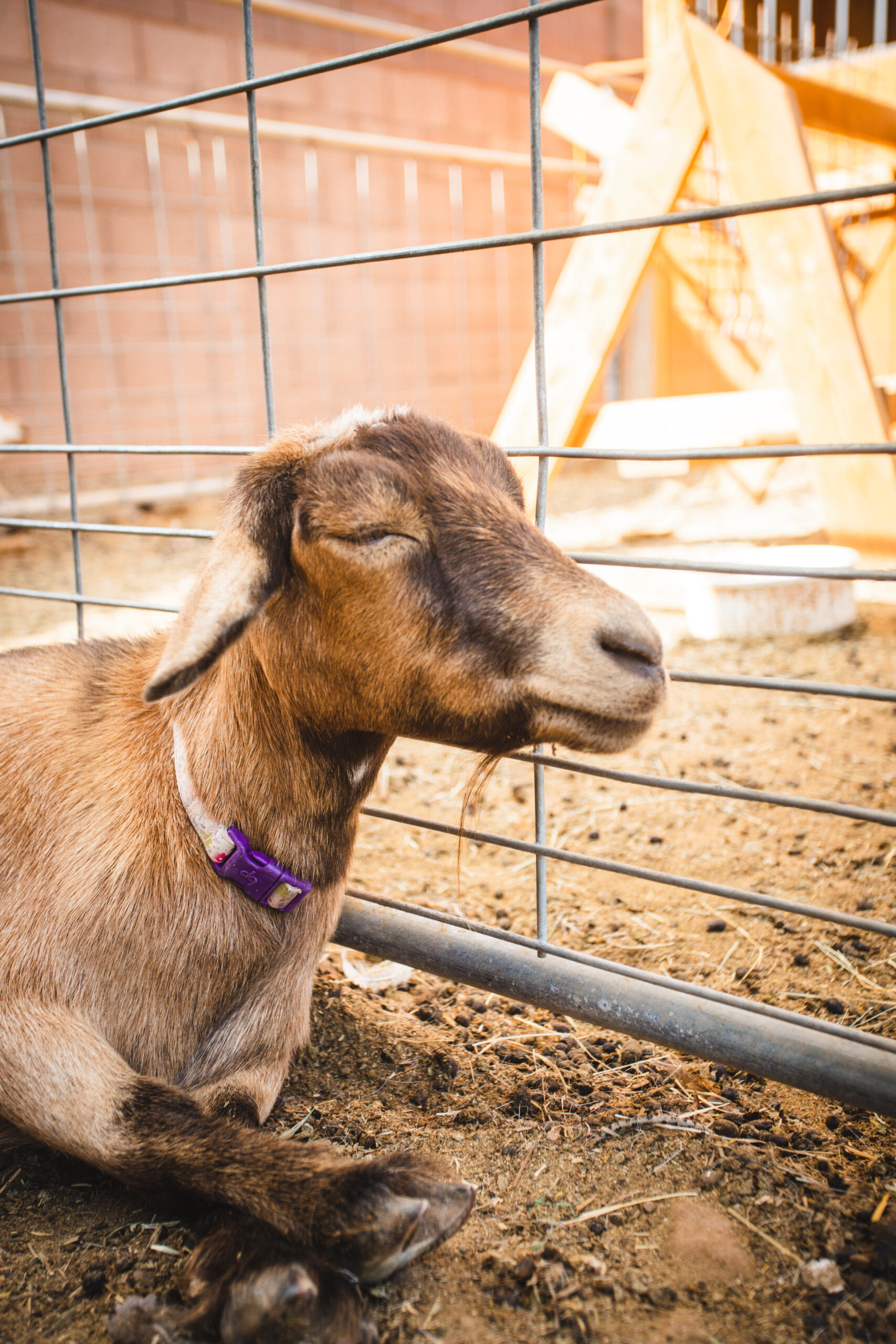
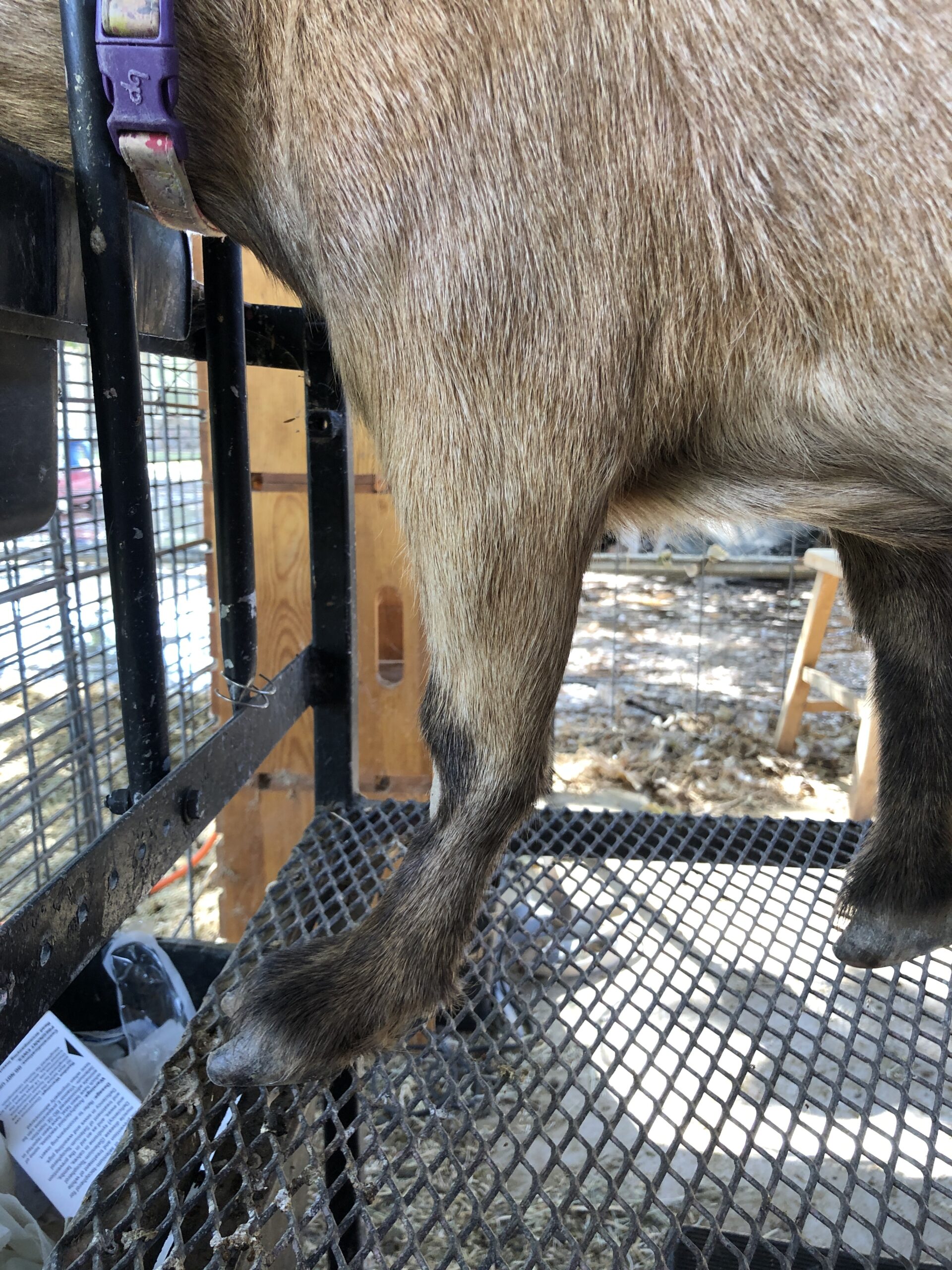
In 2016, in our search for an older doe who was a good milker & good mama, we came across a hardy doe named Penny.
We were told Penny had a slight limp from an injury and since it wasn't too bad, we continued to breed her and milk her over the years.
In 2018, she gave birth to our famous little Willow and in 2019 we realized her limp was much worse and was actually a defect called carpal hyperextension. We saw the beginnings of it in her daughter Willow, so we stopped breeding and did all we could to help Penny.
In the end Penny struggled so much with walking that we noticed she had stopped eating and was losing weight. It was at this point we decided to euthanize Penny.
DORIS & MABEL
2017-2020
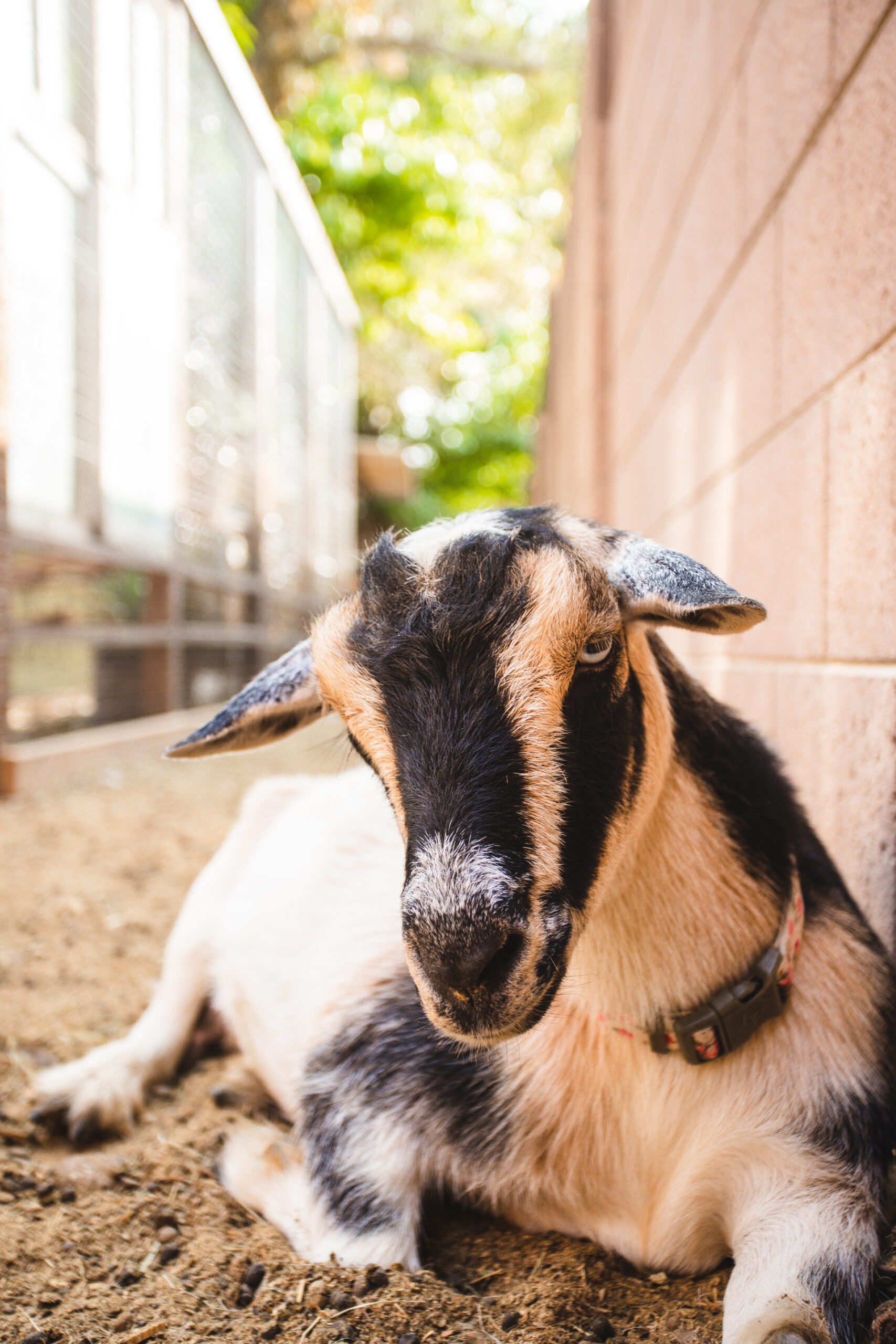
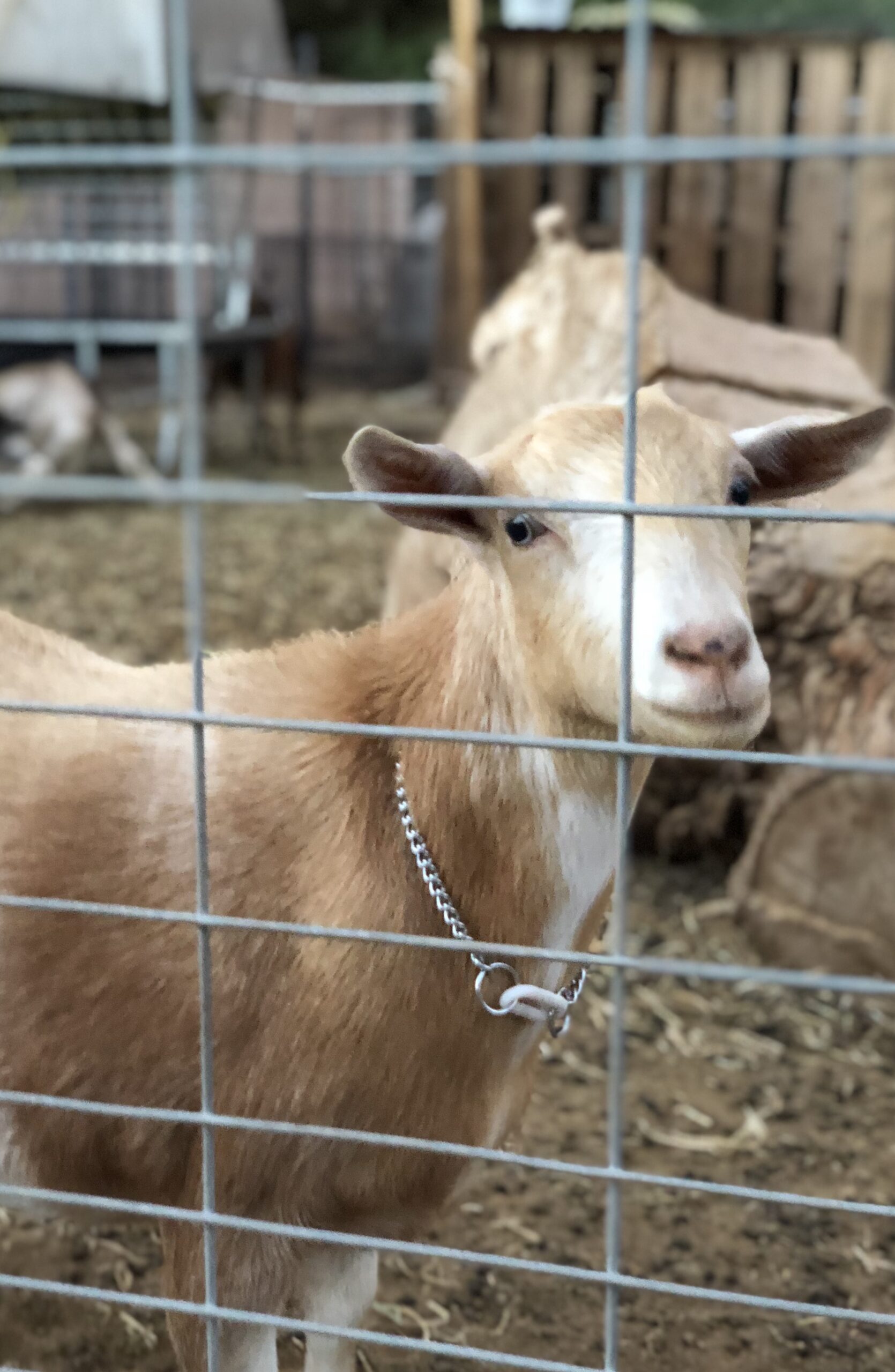
In 2017, we purchased two new Nigerian Dwarf milking does we named Doris & Mabel. We were excited to bring new bloodlines into the herd and it was just in time for breeding season.
Unfortunately, we could never get Mabel bred. She was quite a strong doe and would bully the buck (and often the other does). She also seemed to have it out for our little Willow, so we made the decision to rehome her in 2018. She was rehomed a few times and finally settled in a herd in northern Arizona where I'm told she's kidded a few times.
We kept Doris for much longer, and while she didn't seem to produce very much milk, we enjoyed her personality towards humans (very sweet). Unfortunately, Doris too became a bully and decided that Tilly would get the brunt of her headbutts. In the end I decided it wasn't worth it to keep a doe that could harm the others (Doris was a rather large doe). In 2020, Doris was sold to a Nubian farm in Tucson, AZ, where she continued to bully even the larger goats, so she was eventually sold to an older woman as a lone goat, where Doris seems to be happiest.
Now that I know more about proper body conformation, I can see how these two sisters had very low dairy character. Their bodies put their energy into muscle production and less into putting milk in the pail. The problem with raising/breeding these types of goats is that they tend to consume high amounts of hay/feed (to maintain their body composition), yet they don't produce enough milk to truly classify them as a dairy goat. In addition, a bulkier goat will be stronger, and be likely to bully the herd -- which is exactly what happened with Doris & Mabel. I'm glad I had the experience of raising goats like this because I know what to avoid when making decisions for my dairy herd.
STELLA & ASTRID
2019-2021

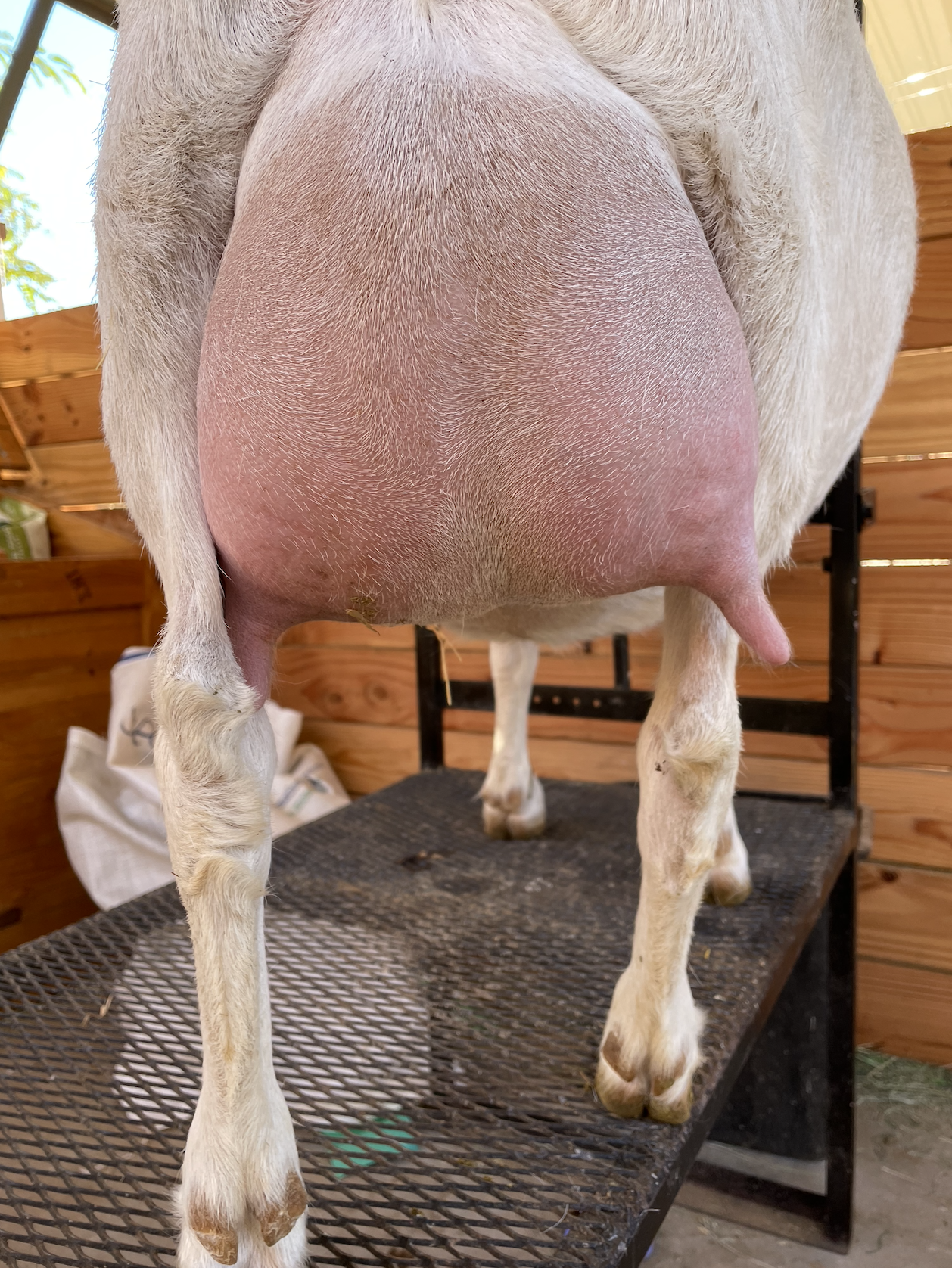
In January of 2019, our only Nubian and favorite of the farm, Luna, gave birth to a single doeling we named Stella. At the time I was hoping to get more milk out of a crossbred goat, with Stella being half-Nubian & half-Nigerian.
We raised Stella up for a year, bred her, and in January of 2021 Stella gave birth to twins. We sold her buckling as a wether (pet) and let Stella raise up her doeling as I assessed her udder and milk production. Unfortunately, Stella had teats that pointed to out towards her legs, causing more bacteria to get into her mammary system. Also, she did not inherit Luna's sweet personality (instead she was rather loud & cantankerous), and she did not enjoy being pet or being brought to the milking stand despite us loving on her all throughout her younger years.
In the end I had to make a decision on if I wanted to continue to breed crossbred goats or stick with purebreds. I realized my heart was with the Nigerian Dwarf breed, and to really make an improvement to my herd, I'd need to keep only registered purebred stock. I decided to sell Stella & Astrid together to a new owner who was more interested in breeding mini-Nubians.
Stella and Astrid still live on that farm today in Modesto, California.
FERN
2019-2022

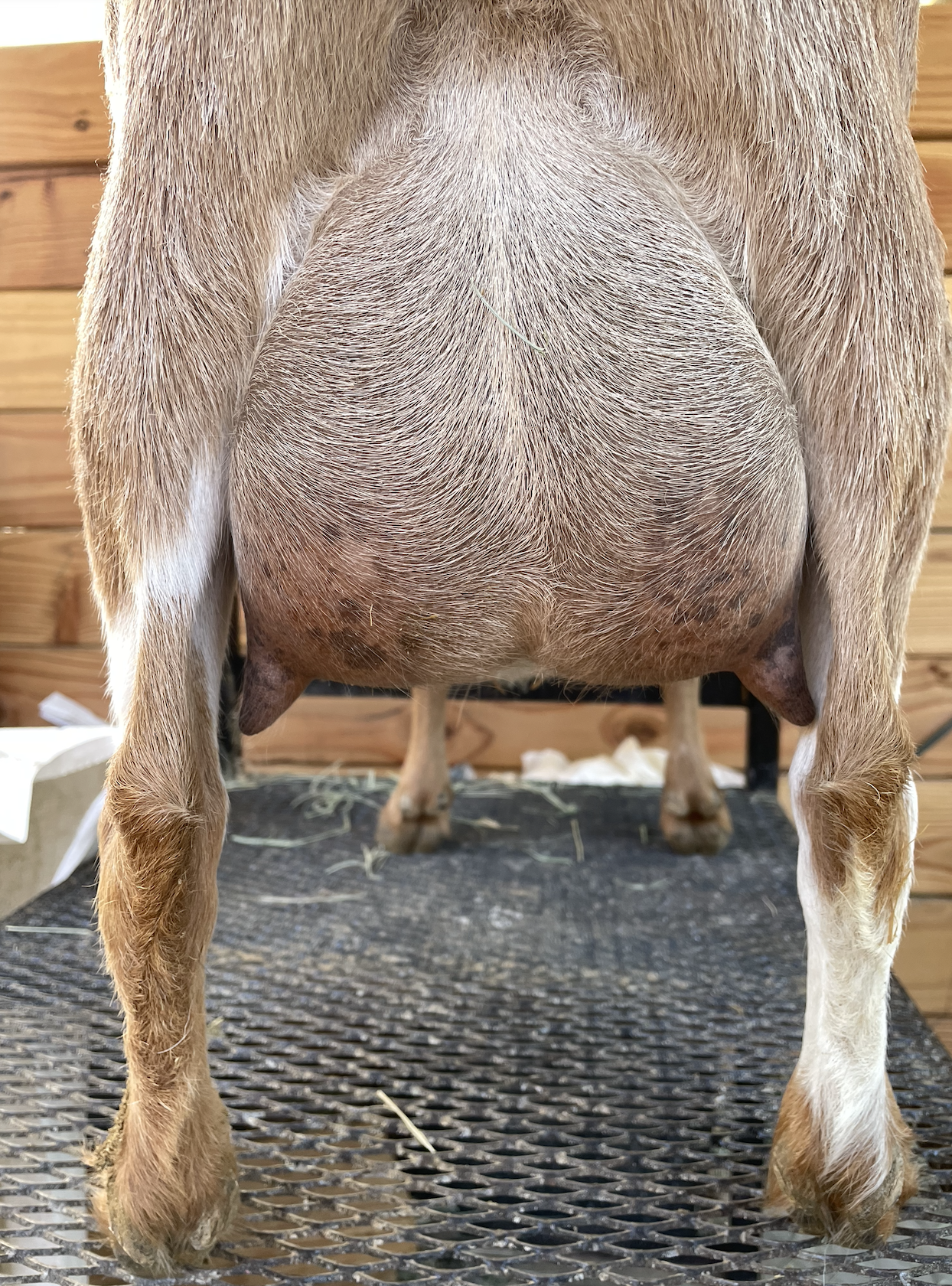
In January of 2019, Tilly gave birth to twin doelings, and we decided to retain Fern, while her sister Hope went to live with Lumnah Acres in New Hampshire.
Fern was a sweet doe but she had less dairy character than I'd hoped and had a very meaty and hard to milk udder. In addition, her teat placement meant that they rubbed on her legs and caused bouts of mastitis. She did have a very long and wide body but ultimately it was not what I wanted to continue.
We decided to sell her to a local farm and she still lives on that farm with her daughter, Rose.
WINSTON & WINNIE
2020-2021
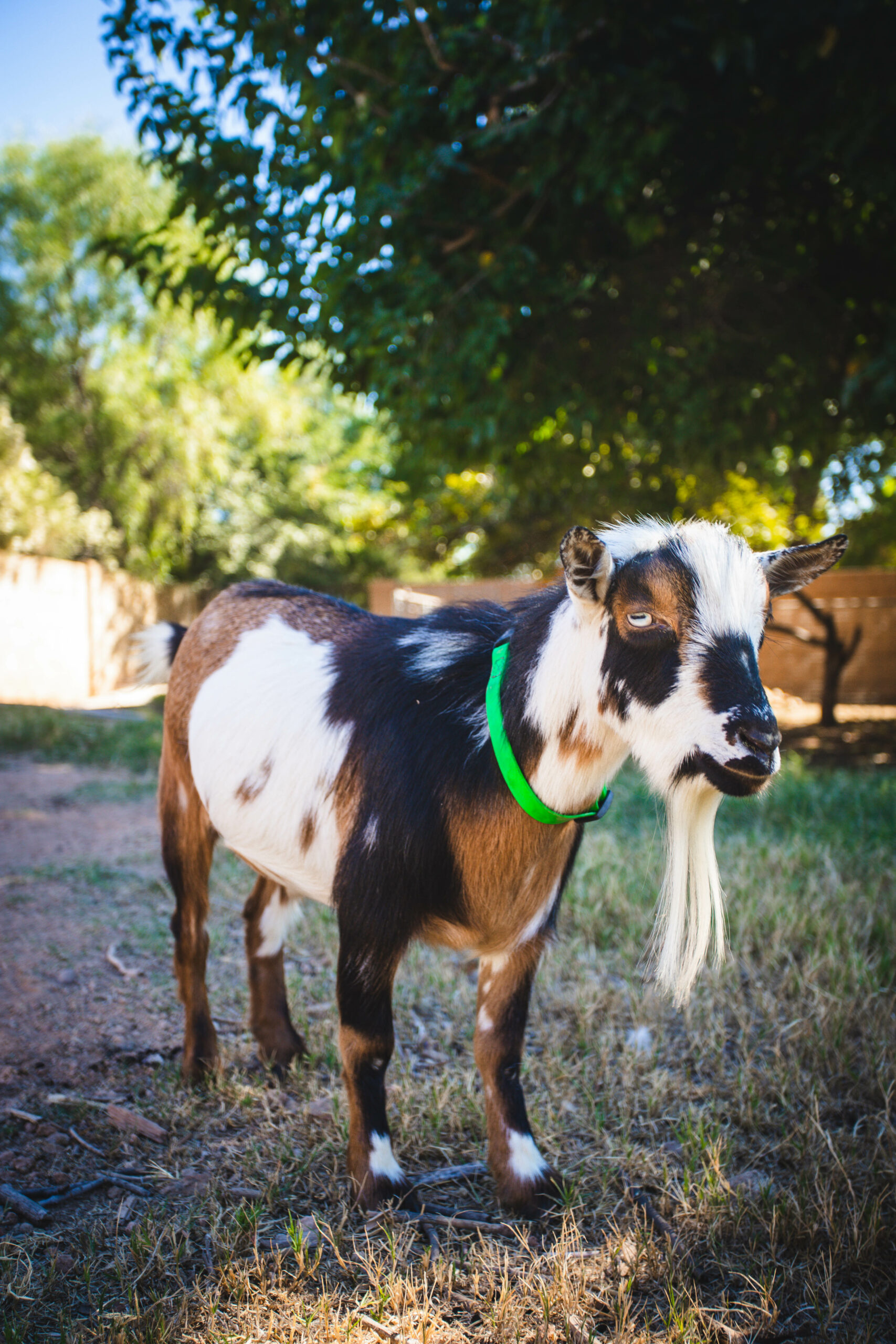
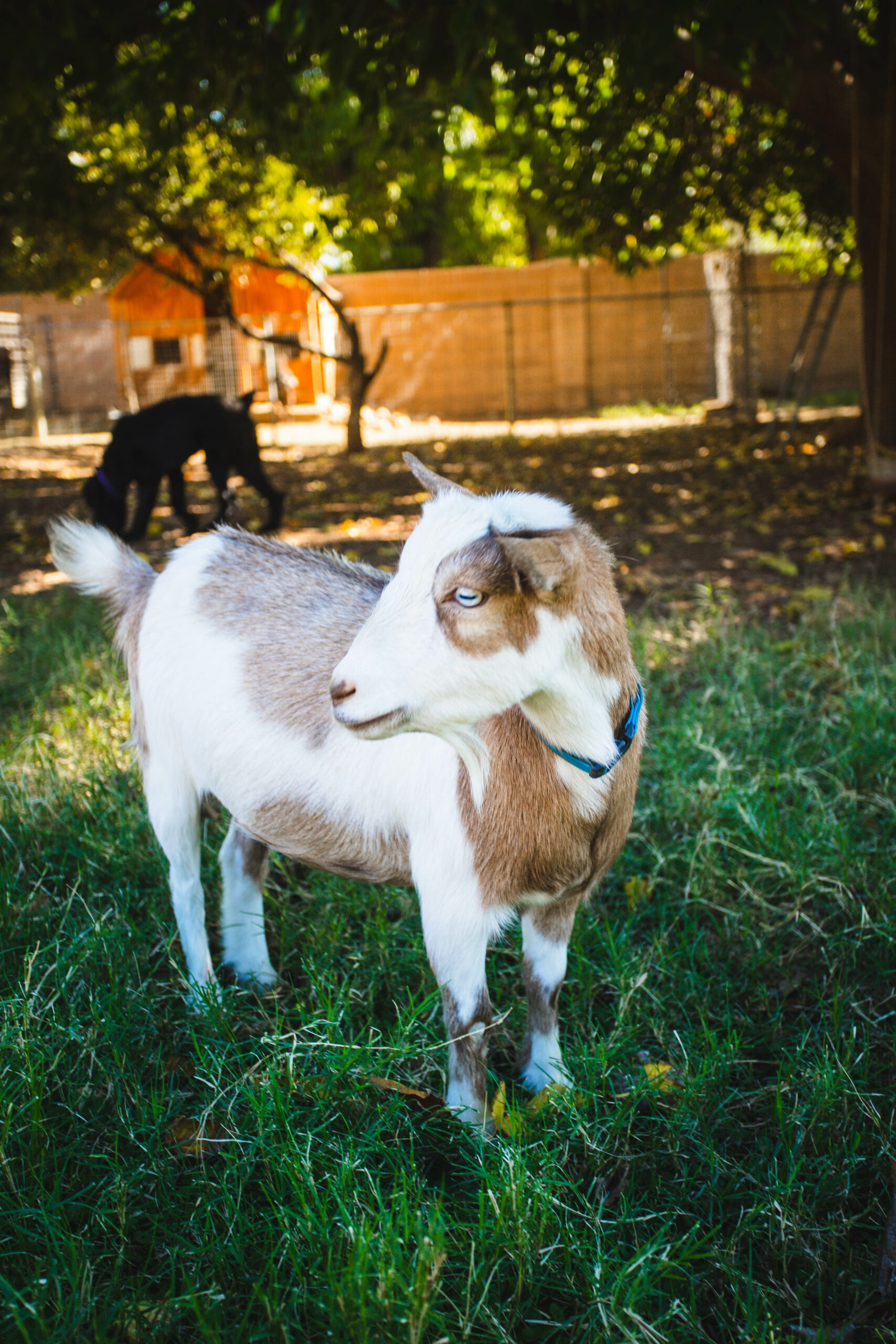
In April of 2020, our sweet Willow gave birth to triplets. Around this same time, we noticed that Willow had inherited her dam's (Penny) leg defect. Wanting to watch closely to see if Willow's kids developed it, we sold one kid as a wether to a friend, kept one kid as buckling, and kept one doeling.
Winston was the buckling we raised for a year and unfortunately at around the 10-month old mark he developed the very same leg defect despite my extensive mineral & vitamin supplementation in an effort to prevent it from developing 🙁 (you can see it in his left leg in the picture) At this point we castrated him.
Even though Winnie never developed the leg defect, I made the decision to spay her because I knew I could never ethically sell kids out of her knowing it was so prevalent in this line. Even if she went her whole life never developing it, she could still pass it on, and that didn't sit right with me.
With already so many retired does kept on the farm, we weren't able to keep more pets, so we said goodbye to these cute goats and they currently reside at a pet goat farm in Queen Creek, AZ.
ZORRO
2020-2023
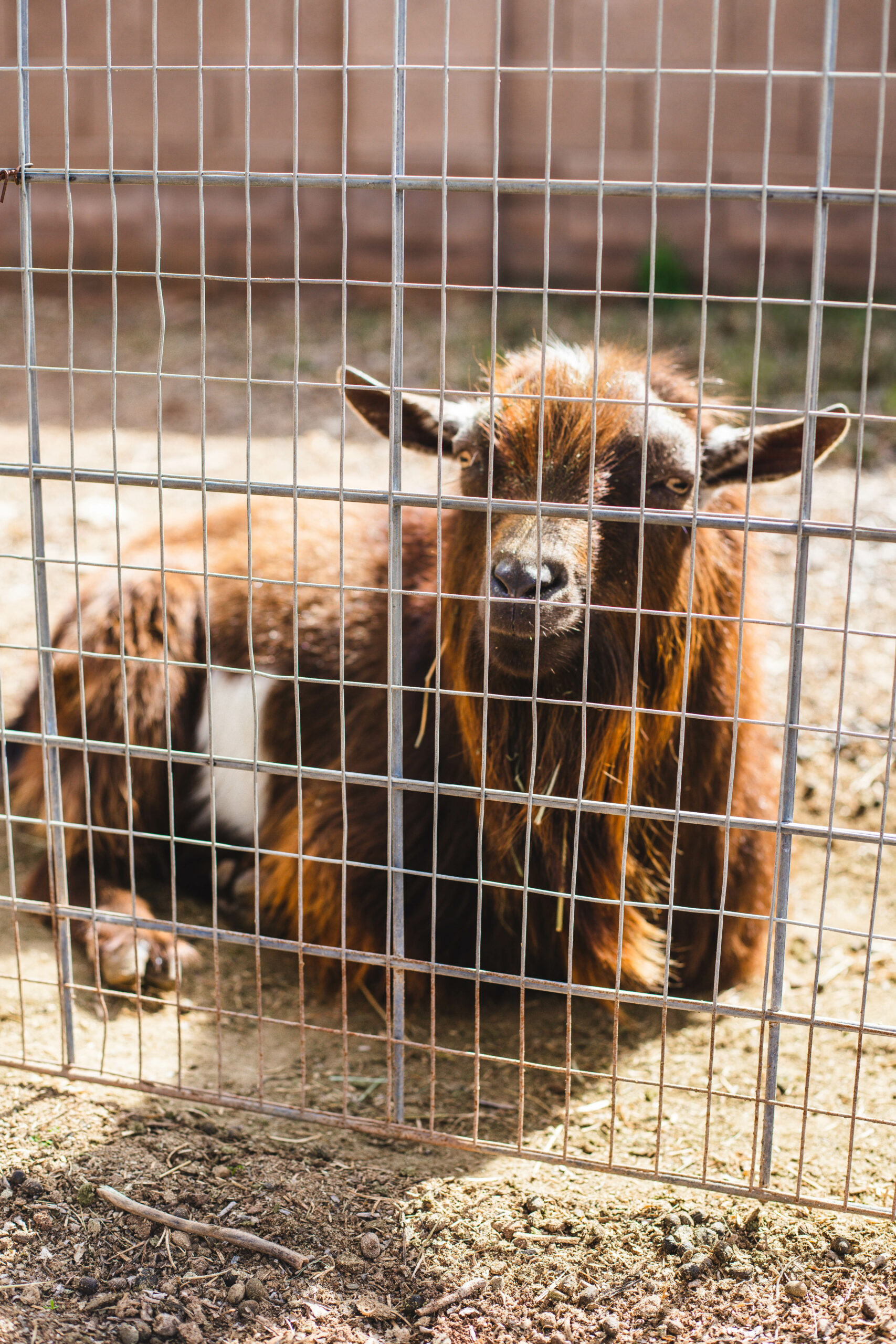
In 2020, after years of renting bucks, we decided it was time to own one ourselves. Zorro was a beautiful chocolate polled buck and we were excited about the milk production genetics behind him.
We bred him to all our does the summer & fall of 2020, and we came out with LOTS of bucklings, haha. We didn't have many daughters to raise out of him except for Raven, so we kept her and then bred him again the following year to some of our yearlings.
One of my biggest concerns with Zorro was his narrow rump. However, sometimes how a goat looks (phenotype) isn't necessarily what they pass on genetically (genotype). When the second year of his offspring was due, I saw a 50/50 split on some looking narrow and some looking wide, so it was a tough call. He did have some great production & mammary texture genetics behind him, but in the end I decided I needed to prioritize width in my does, so I brought in a new buck that hopefully has this trait and let Zorro go to make room.
Zorro currently resides in Buckeye, AZ on a farm as a breeding buck.
NAPOLEON
2021-2022
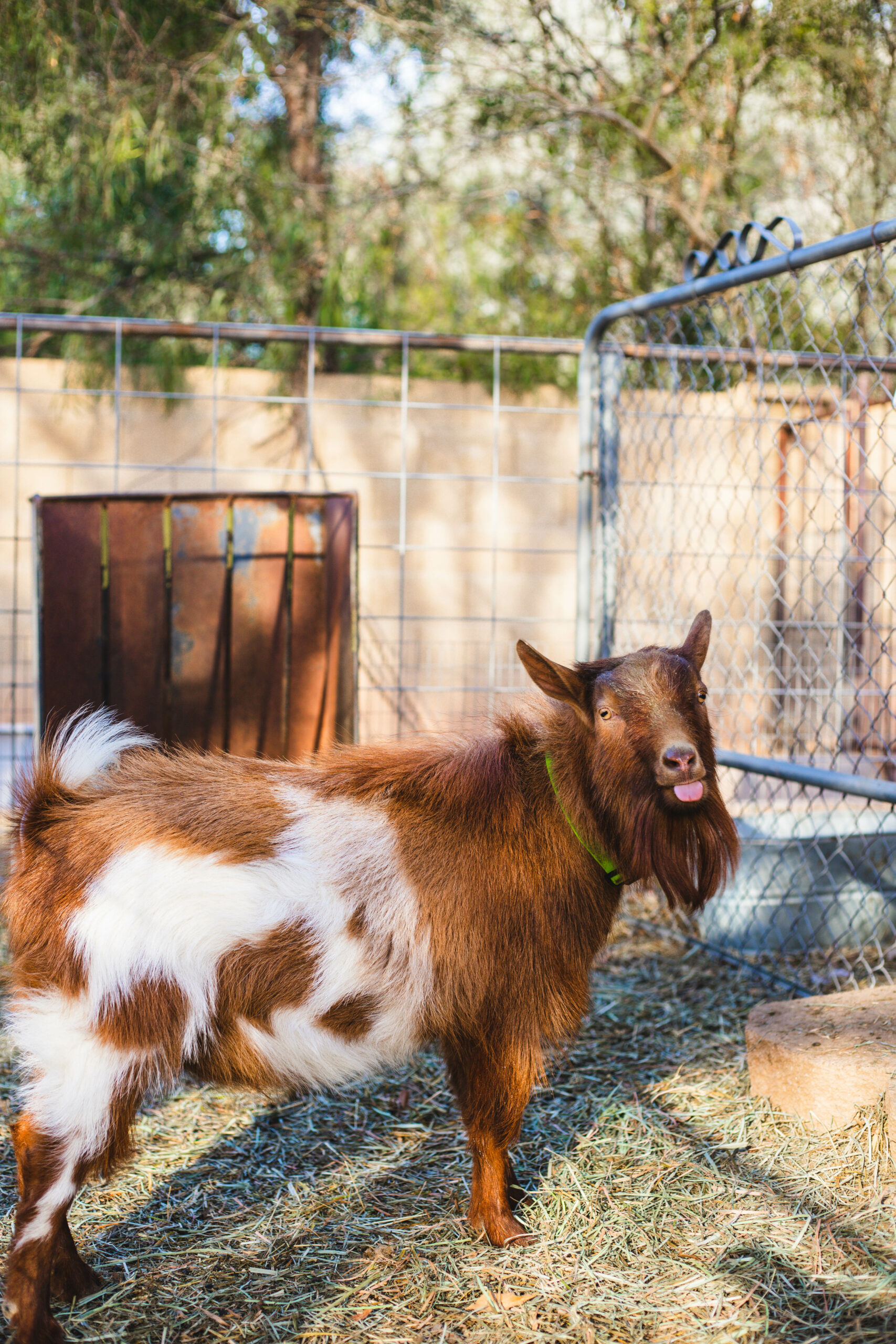
In 2021, we brought a beautiful buck here all the way from Pennsylvania. I was so excited about his udder genetics I was hoping to bring to our herd. His dam had an amazing wide rump and wide udder attachments.
We bred Napoleon to a couple of our does and then let a friend borrow him for her breedings. Unfortunately, Napoleon suffered a severe break of a front leg that could not be repaired. (rear legs can sometimes be casted on goats, but front legs are more daunting)
He was euthanized and we never got to fully get the genetics out of the boy like we had wanted.
HAZEL
2021-2023
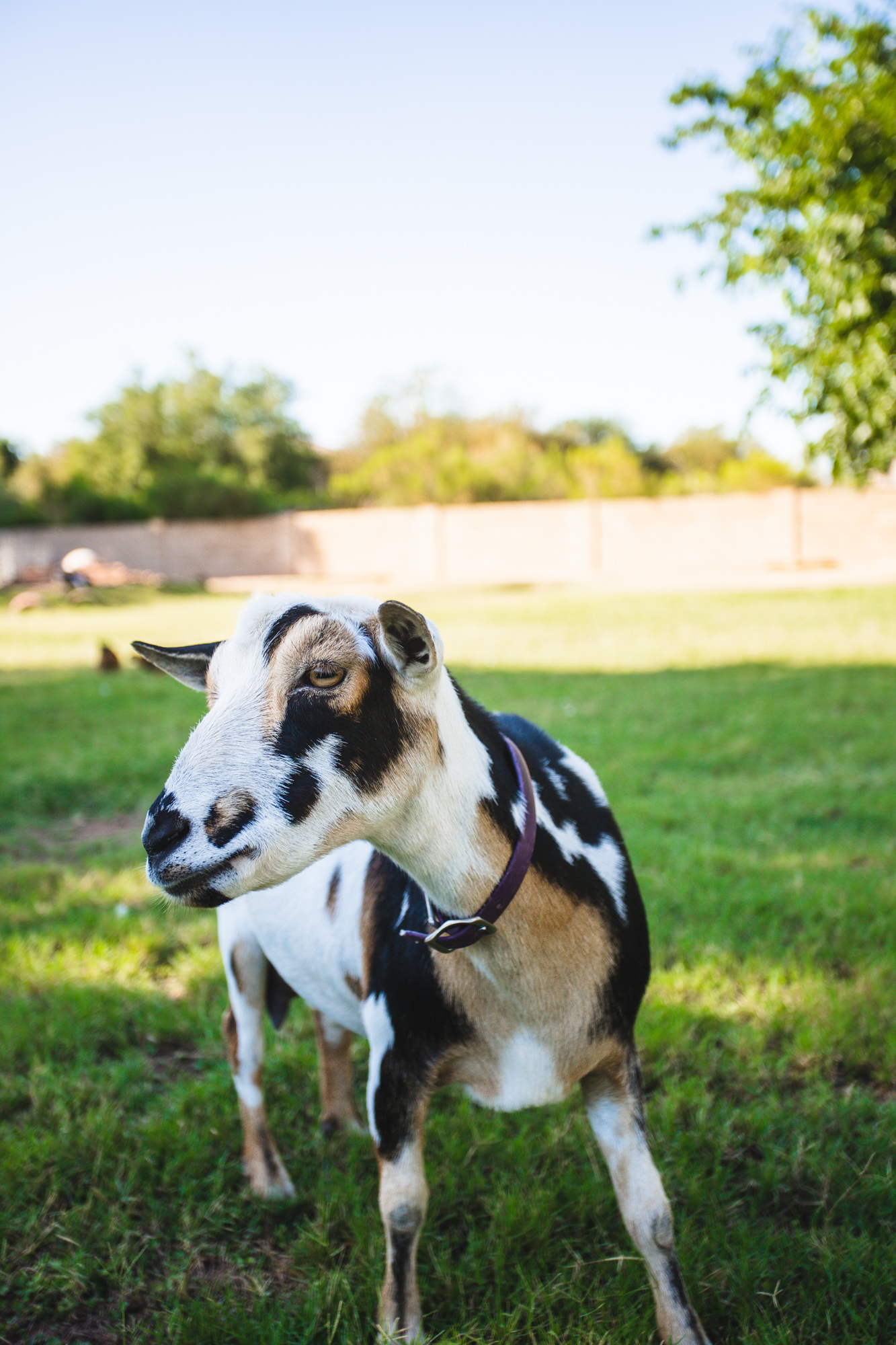
In 2021, a local friend decided to sell their farm and needed to board all their goats. We offered to take Hazel as I really loved her dam & sire and wanted to see if I could incorporate new bloodlines into my herd.
Hazel was a sweet doe that was easy to have around the farm. She was a good mama and good milker. Unfortunately, in the two years we bred her, she gave a buckling, then two does that we ended up selling. (They looked great, but in the end we chose other doelings to retain)
In 2023, Hazel went back with her new owners and they were so happy to have her back! She was shown in a local fair and won in the youth division.
OLIVE
2021-2023
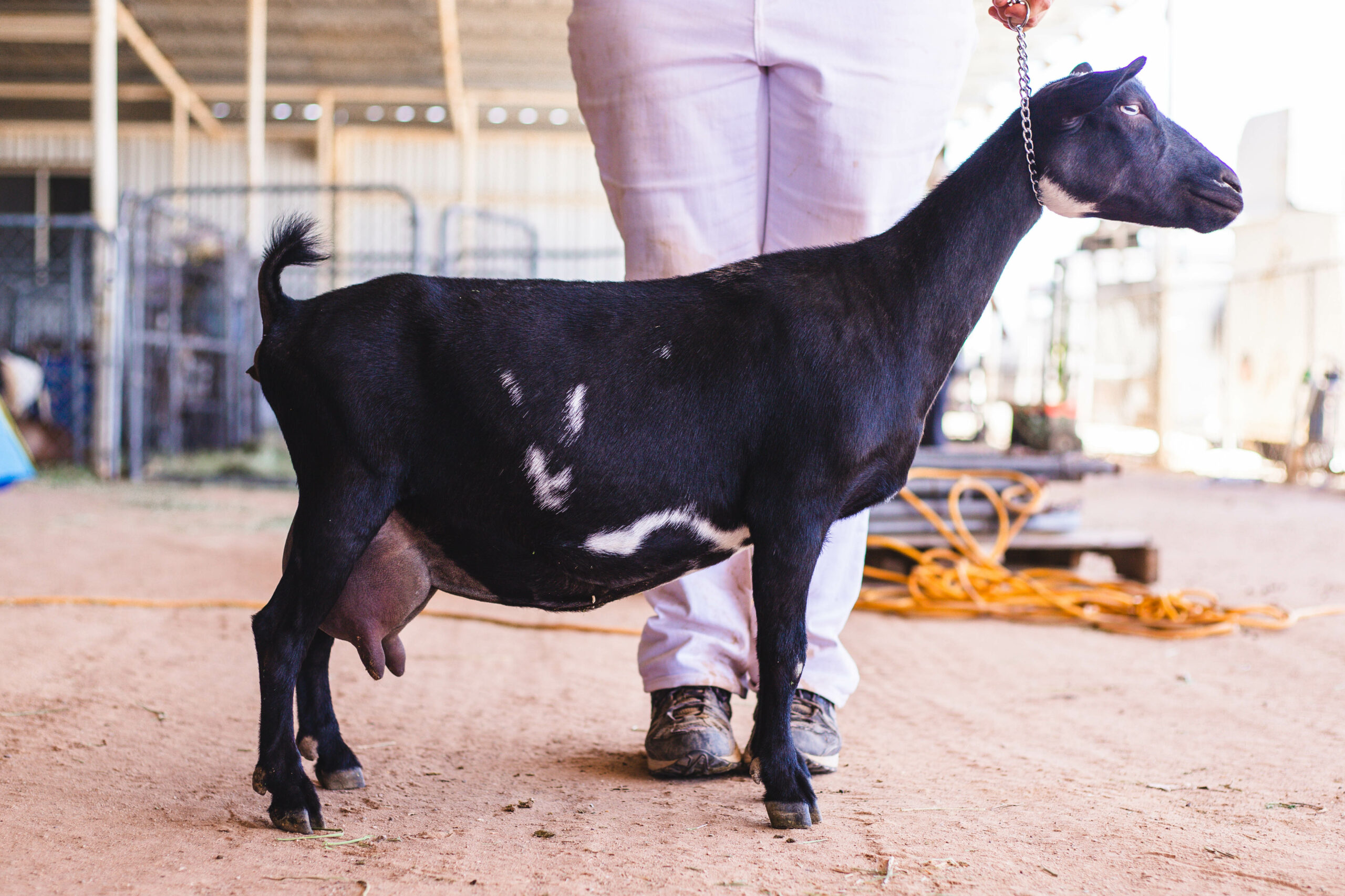
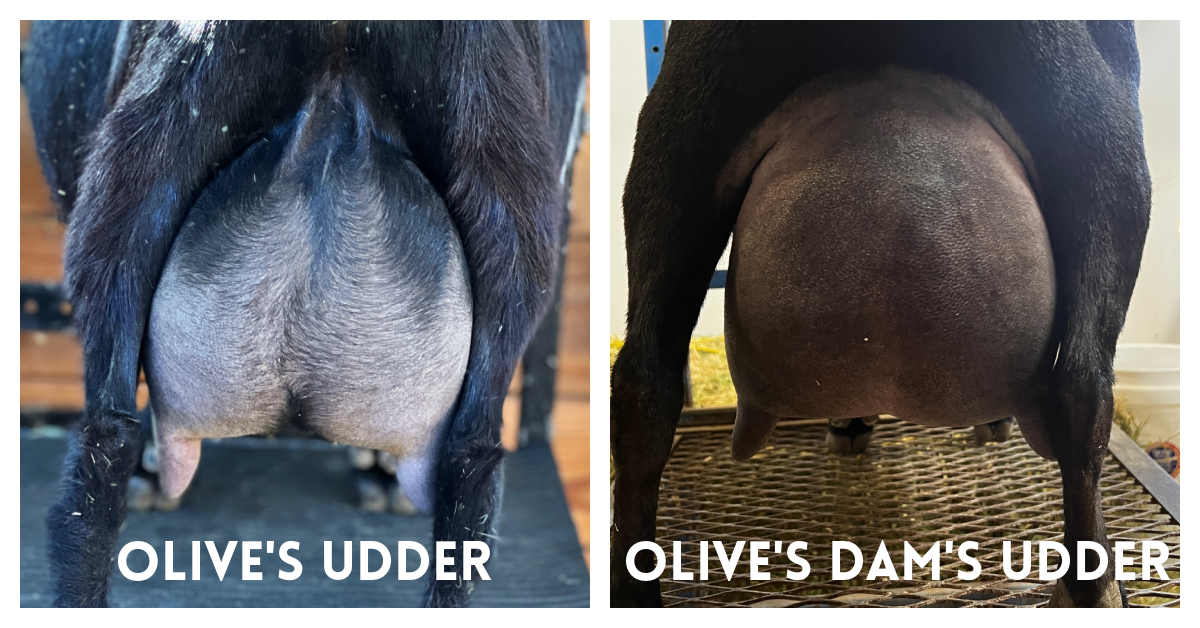
In 2021, we brought Olive to our farm, in the hopes of increasing milk production with her fantastic production genetics.
Unfortunately, while Olive did inherit her dam's production, she somehow did not inherit the udder attachments needed to secure her udder in place (genetics are wild, guys). Weak attachments at a young age can indicate the udder will be hanging very low as she ages, making her more prone to infection & injury.
We kept her another year as we decided what to do (we loved Olive so much), but after her 2nd freshening we decided that keeping her meant we could never sell kids of worth out of her, and we may be heading down the wrong direction for our herd by continuing to use her genetics. I could have spend a few years trying to breed out this issue, but in the end I decided it was much easier to just go with the udders in my herd that were already well attached.
Olive went to a farm whose owners simply wanted a doe who was sweet & easy to milk.
RAVEN
2022-2023
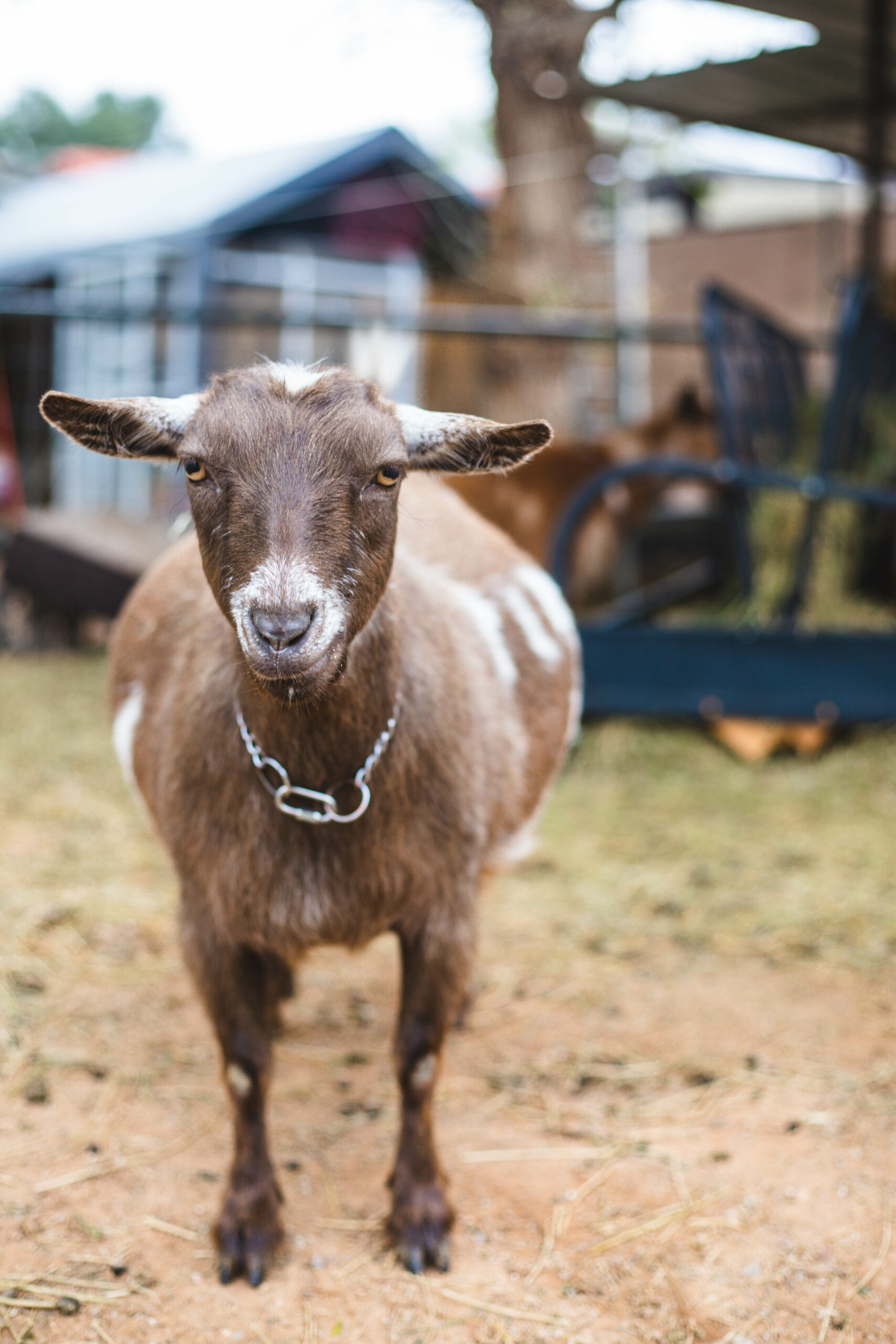
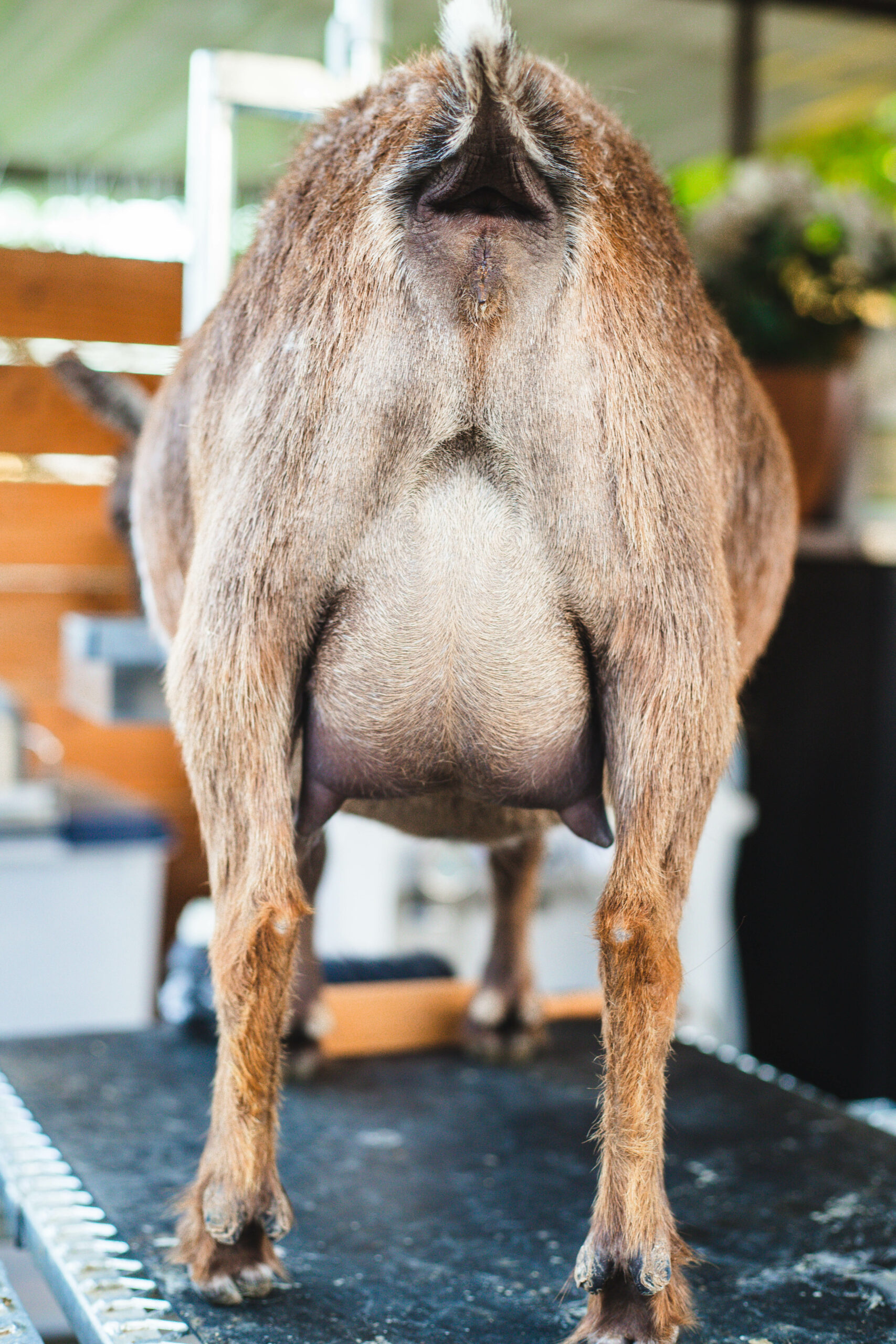
In 2022, one of our older does, Tilly, delivered twins. I was impressed with the doeling's uphill carriage and decided to raise her up to see how our buck Zorro had improved upon Tilly.
Raven had a bit of a bumpy road -- she short-cycled early in her pregnancy, then after another successful pregnancy, she delivered twins 10 days premature. After we all recovered from that, I took a closer look at her udder and was a bit stumped. While her udder texture was buttery soft and she was a dream to milk, she did have the dreaded "winged out" teats. Sometimes after a 2nd freshening these can straighten out as the medial suspensory ligament hold, but it was still a gamble. This, combined with her starting to dip in her chine (mid-back), was what ultimately made me decide to let her go in 2023.
She currently resides on a farm a few miles from us as a backyard milker.
DOLLY
2022-2023
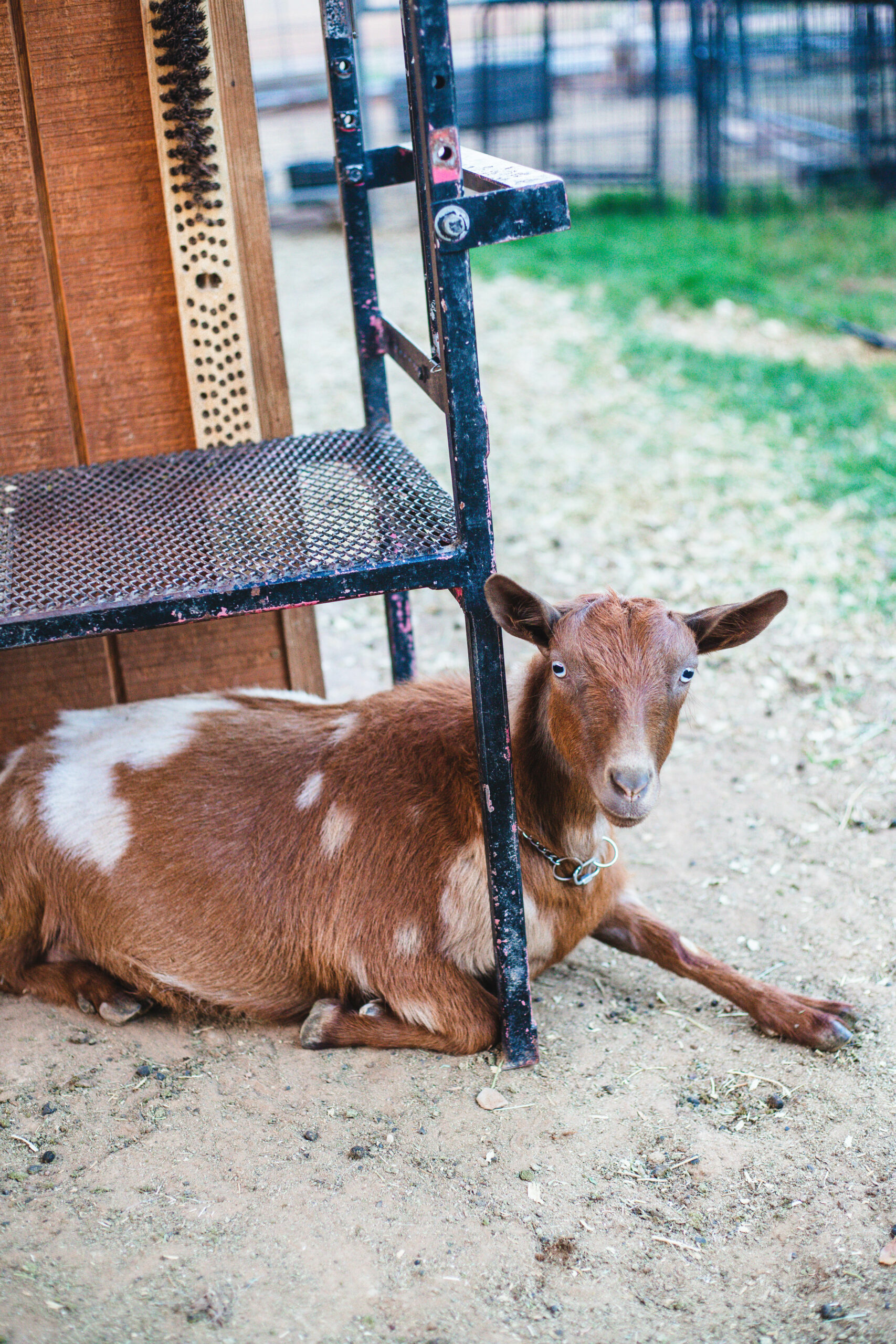
In 2022, our prized doe Daphne delivered twin doelings out of our new buck Napoleon. In an effort to observe how siblings' genetics can express, I decided to raise up both for a year.
I knew I would eventually choose between them and they looked very similar in body type all the way up to kidding so I guessed they might have a similar mammary system. I was shocked to see such a drastic difference in their udder fills at 3 weeks post-kidding (pictured below at a 12-hour fill).
Dolly had a more narrow rear udder attachment, it was slightly twisted, and in general it was much smaller & lower in production. What's also interesting is that Dolly delivered quads that year while Reba delivered only twins. So, with that information, a 12 hour fill should give Dolly a much larger amount of milk. However, one of Dolly's worst traits is that she did not enjoy feeding her kids. One kid ended up passing away so she had triplets to care for and she regularly would sit on them if they tried to nurse too often. Oof.
In the end we sold her to the same farm as Raven in 2023 and she is a backyard milker.
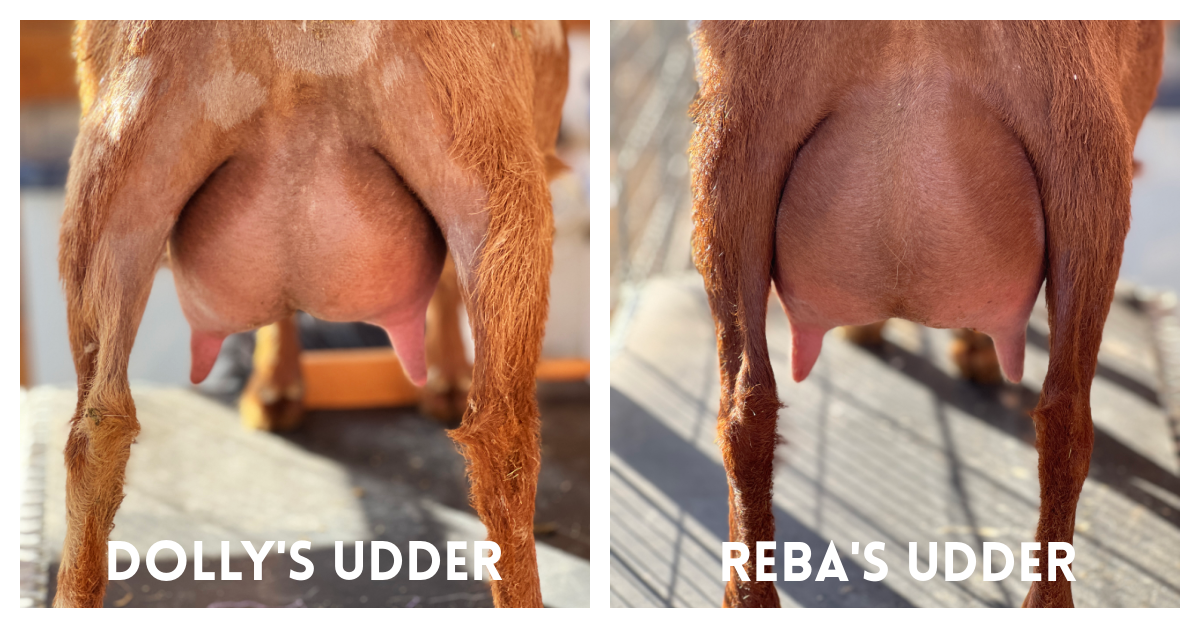
TATUM & LOLA
2020-2023
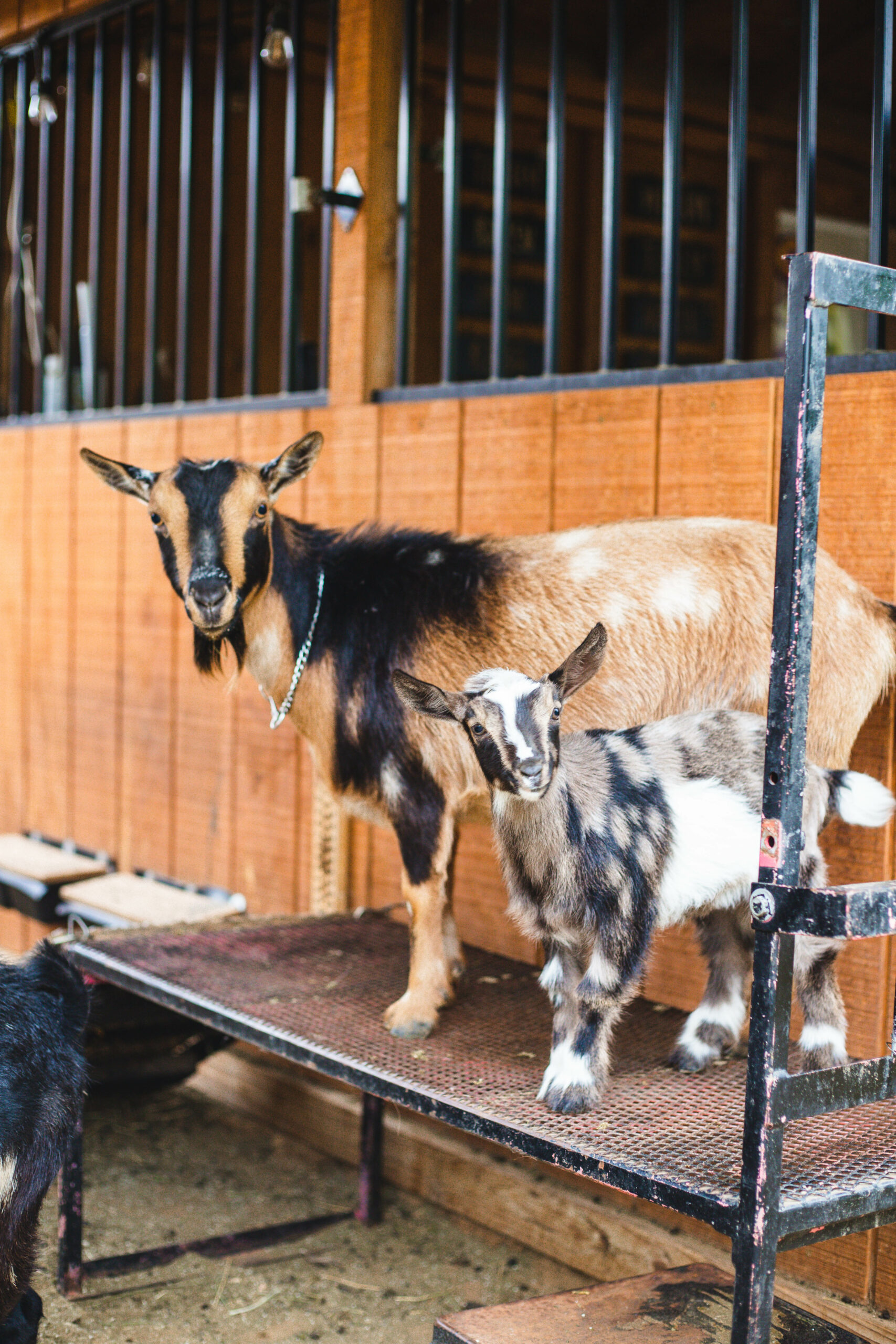
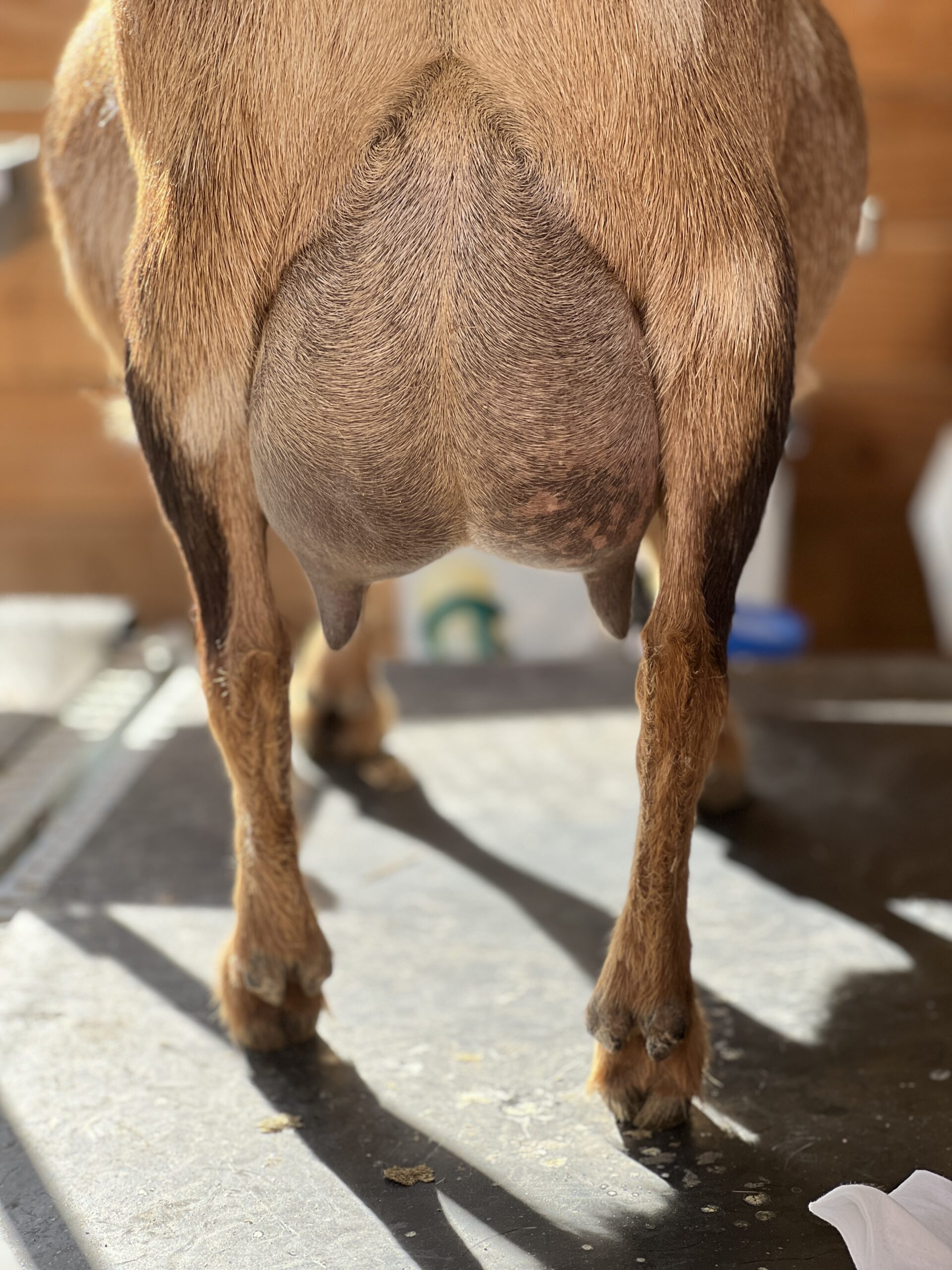
In 2020, Tilly gave birth to a single doeling who we fell in love with. Tatum was shown as a dry yearling and ended up winning both Jr. Grand Champion and Best in Show at a local show in 2021.
Unfortunately, when she freshened, while her udder had all the makings of a great mammary system -- strong attachments, good teat placement, good medial suspensory ligament -- she just didn't have the capacity or production. Only making 1-2 cups a day, we chalked it up to her being a first freshener and gave her another year to develop. After her 2nd freshening we discovered the same thing. Great looking udder, but on the small side and very low production. She also had a very "meaty" udder and skin, meaning, it wasn't very flexible like a quality dairy goat should have. Even though her udder looks decent in this photo, it's very deceiving because truly she gives a very tiny amount of milk & most of that udder is just tissue.
We flirted with the idea of retaining her kid, Lola, but as Lola grew we found she was quite narrow in the rump and had very tiny teats, which can indicate a small udder & low production.
It was so hard to let them go but in the end I decided they were both much better off as pets & I needed to let go of the tiny teat & udder line. They left the farm in July of 2023 and currently reside in Colorado.
PRIMROSE EVERDEEN
2022-2023
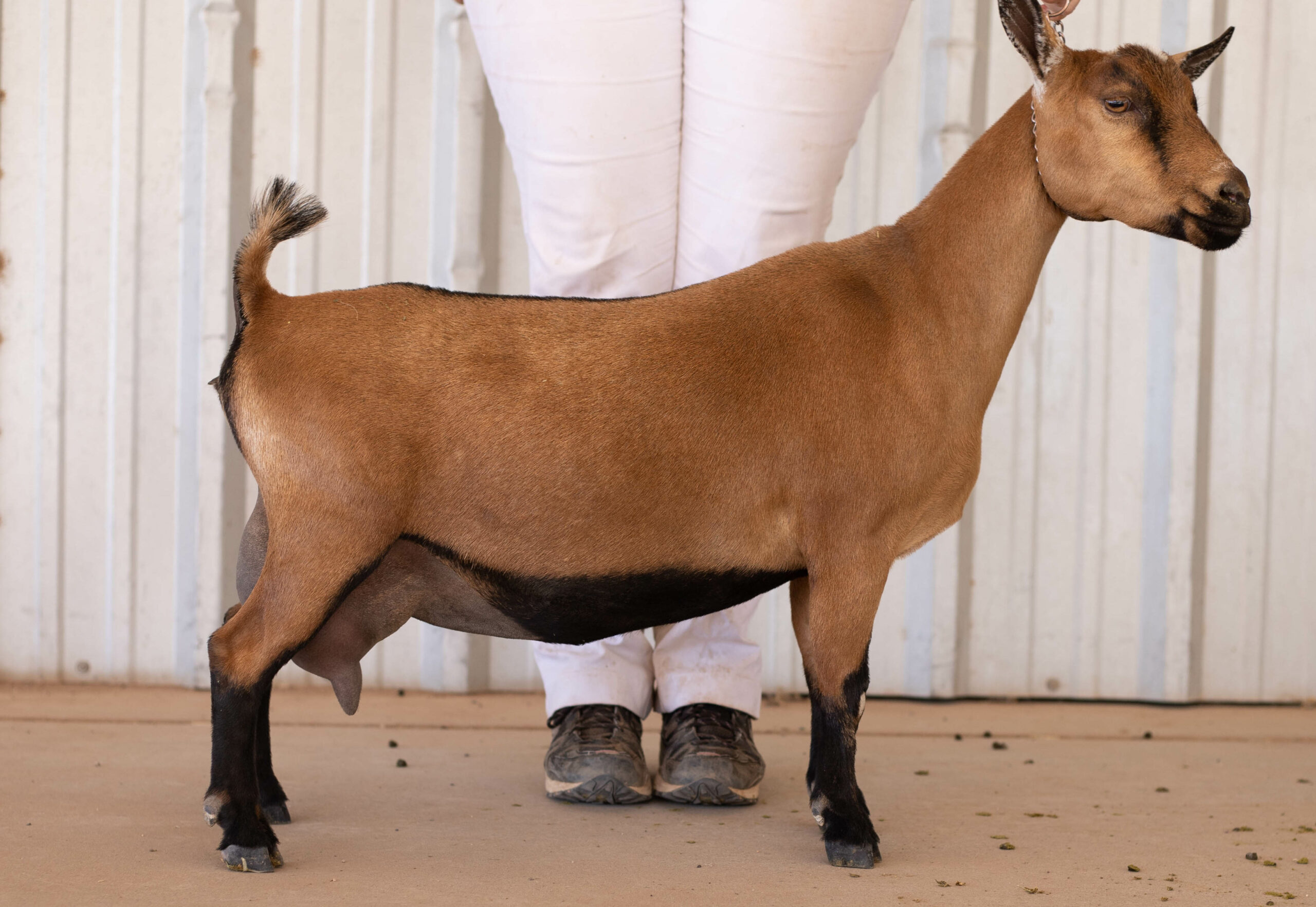
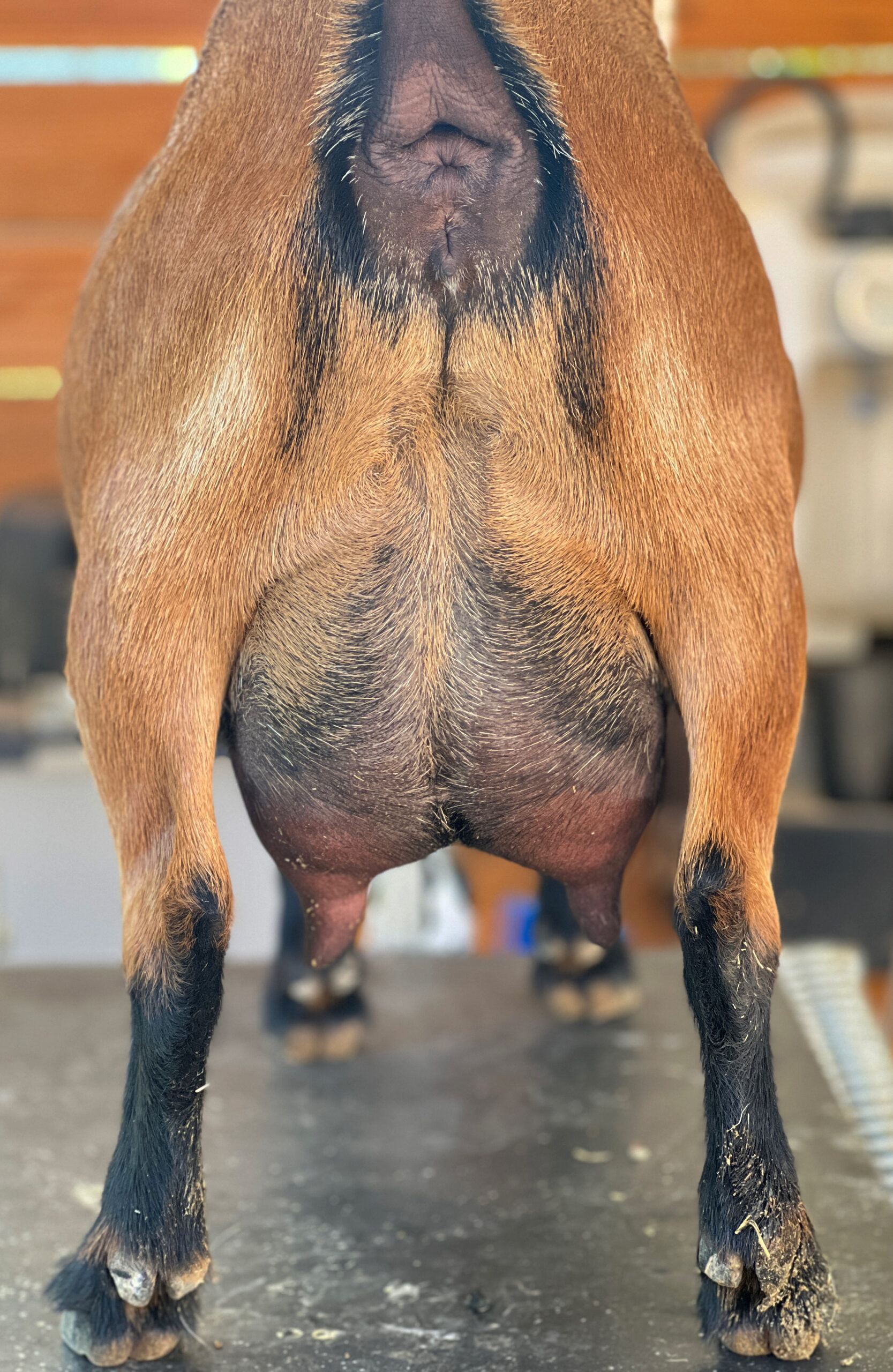
In 2022, we purchased Prim from Johnson Family Farmstead in Oregon and because Prim's dam has a Linear Appraisal score of EEEE90, with a rear udder height score of 40, we were more than excited to see how her daughter would develop.
Unfortunately, Prim didn't inherit some of those traits we were hoping for (though she had fantastic teat placement and udder texture). She also was quite flighty and hard to work with & show.
In an effort to downsize and only keep the best of the herd, we decided to part with Prim. She now lives in California as a backyard milker.
FINNICK ODAIR
2022-2024
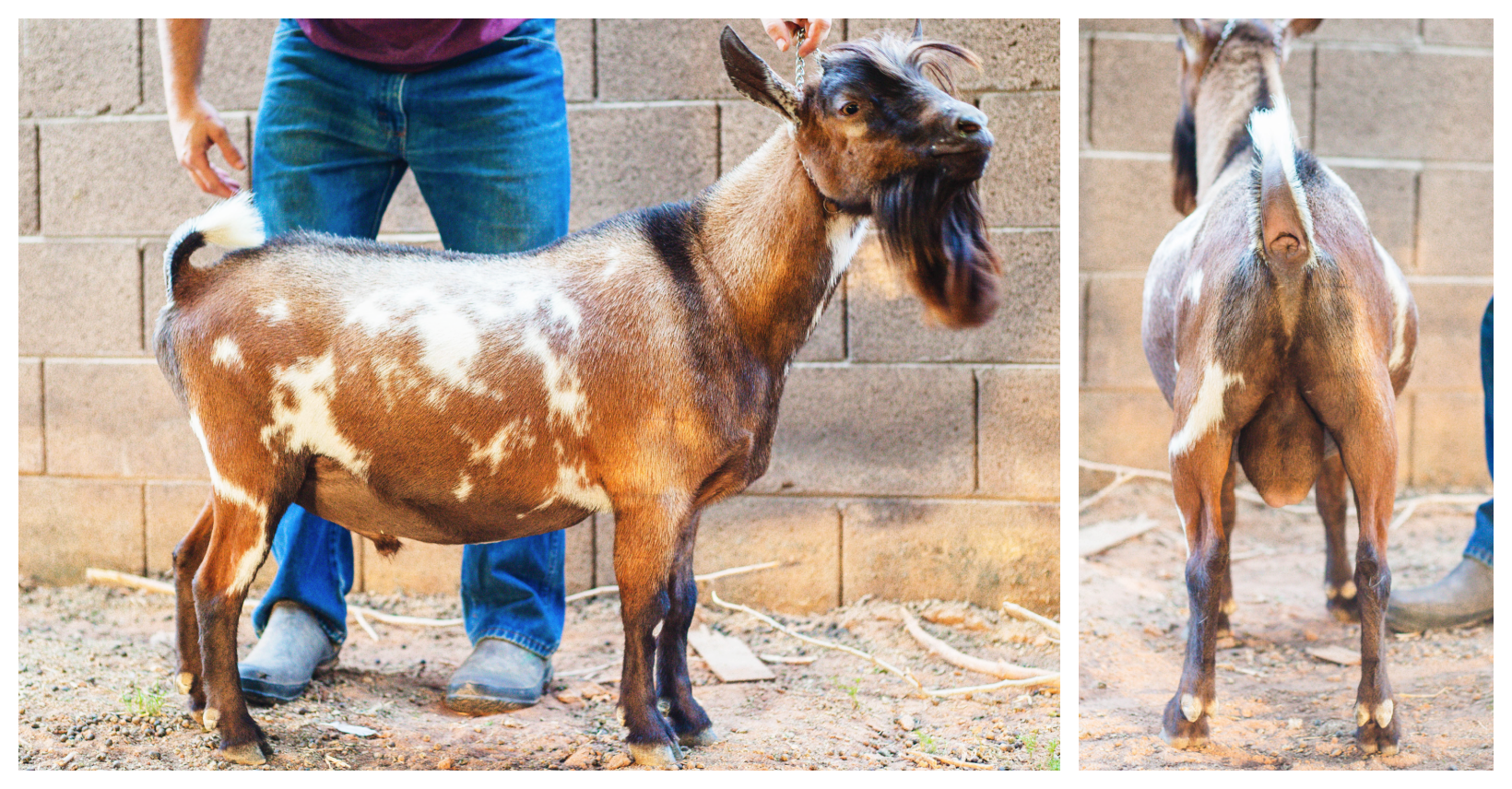
In 2022, we purchased Finnick from Tua Farms in Washington out of their beautiful herd queen, Greta. Tua Farms has some of the best feet & leg structures I've seen, and I wanted to incorporate that strong foundation into my herd.
Finnick produced some beautiful babies indeed with some very strong feet, legs, and impressive front assemblies, but unfortunately he was rather narrow in the rump. (His full brother is quite wide so this is just the nature of how genetics play out:)
After freshening his daughters, and seeing that same narrowness in the rump (sometimes what a buck throws genetics-wise is better than how he himself looks -- but in this case he was indeed producing copies of himself), I decided I couldn't justify keeping him even though I was in love with how he improved front assemblies (and leg structure in general).
This is a frustrating thing with genetics -- sometimes you can take a step forward in one trait while taking a few steps back in another. It's always tricky making these decisions, but in the end I decided I needed wide rumps to be able to have wide, capacious mammaries. The rump is so important for housing the mammary system and you really need that foundation otherwise your girls will suffer in that department.
SHANIA TWAIN
2023-2023
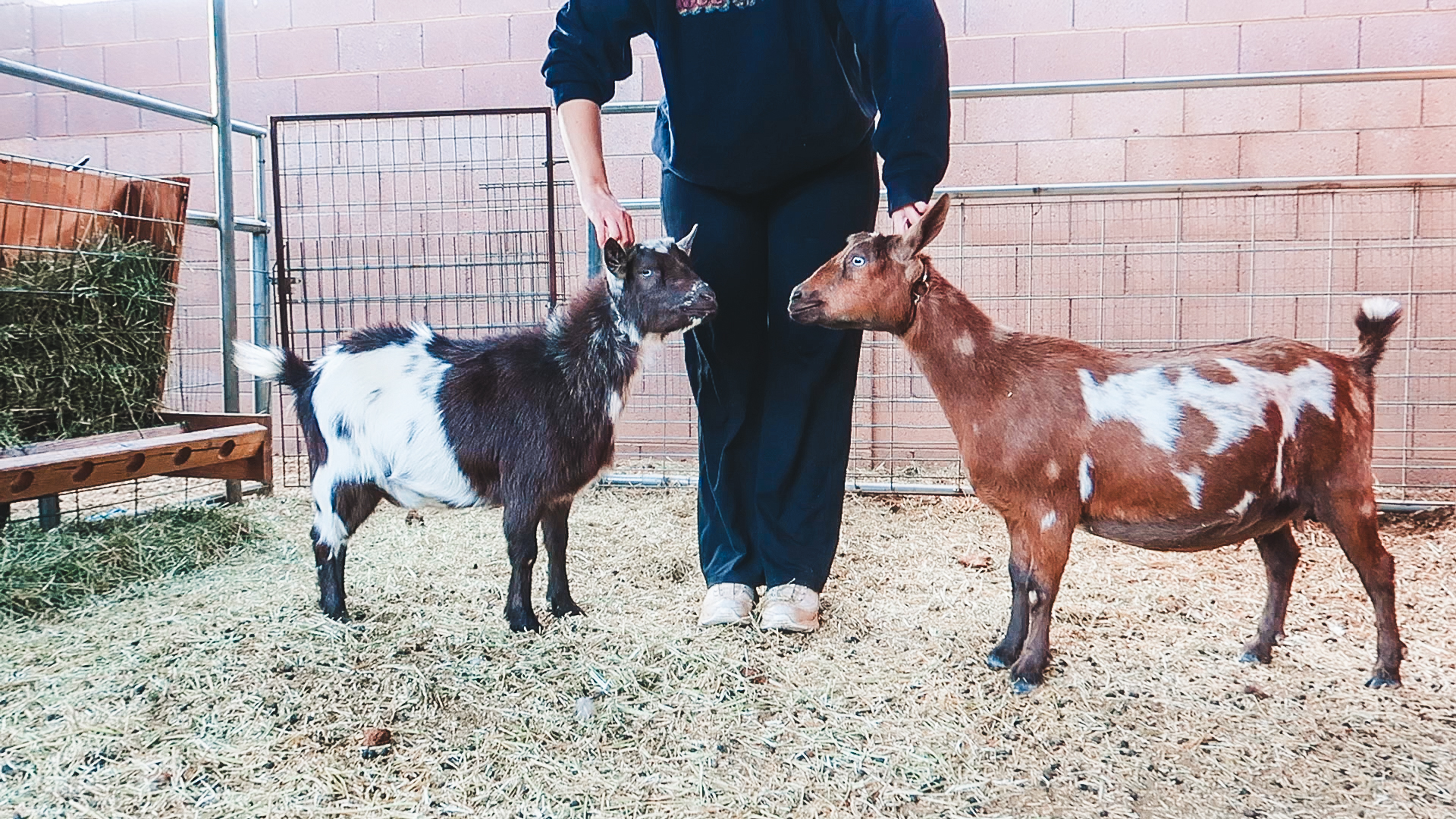
In 2023, Daphne gave birth to 5 kids. 2 of the doelings we decided to keep and name them Wynonna & Shania.
Unfortunately, we could never get Shania pregnant. She was more short-bodied than Wynonna and she did have some trouble as a newborn, so we just aren't sure if it was something genetic or if she could have been underdeveloped from the beginning. Either way, we decided to let her go as a pet.
MISS HONEY
2023-2024
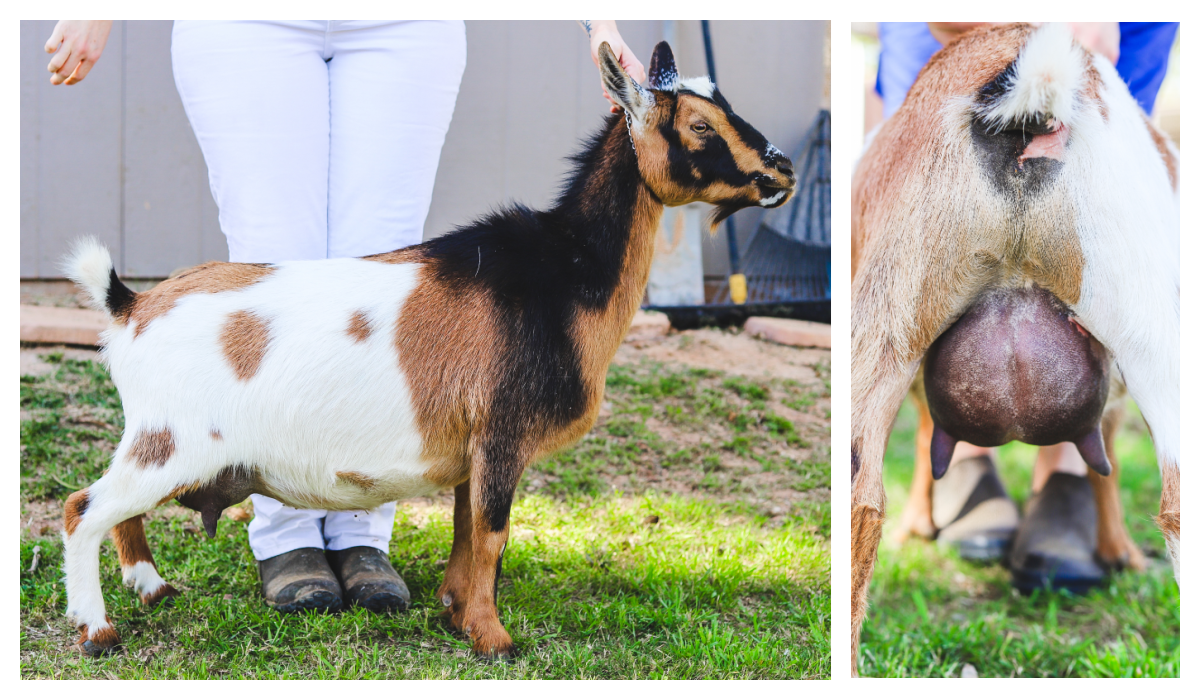
In our never-ending quest to improve the Tilly line (I know, I know), Honey seemed to be one of the most promising does out of our beloved Tilly. With sharp withers, a nice wide rump, and long teats -- we'd hoped she'd be higher quality than her half-sisters before her.
Unfortunately, her very low milk production is what made me decide to stop breeding her and let her go as a pet. However, we did retain a daughter out of Honey and we'll continue down that line until we get improvement:)
WYNONNA JUDD
2023-2024
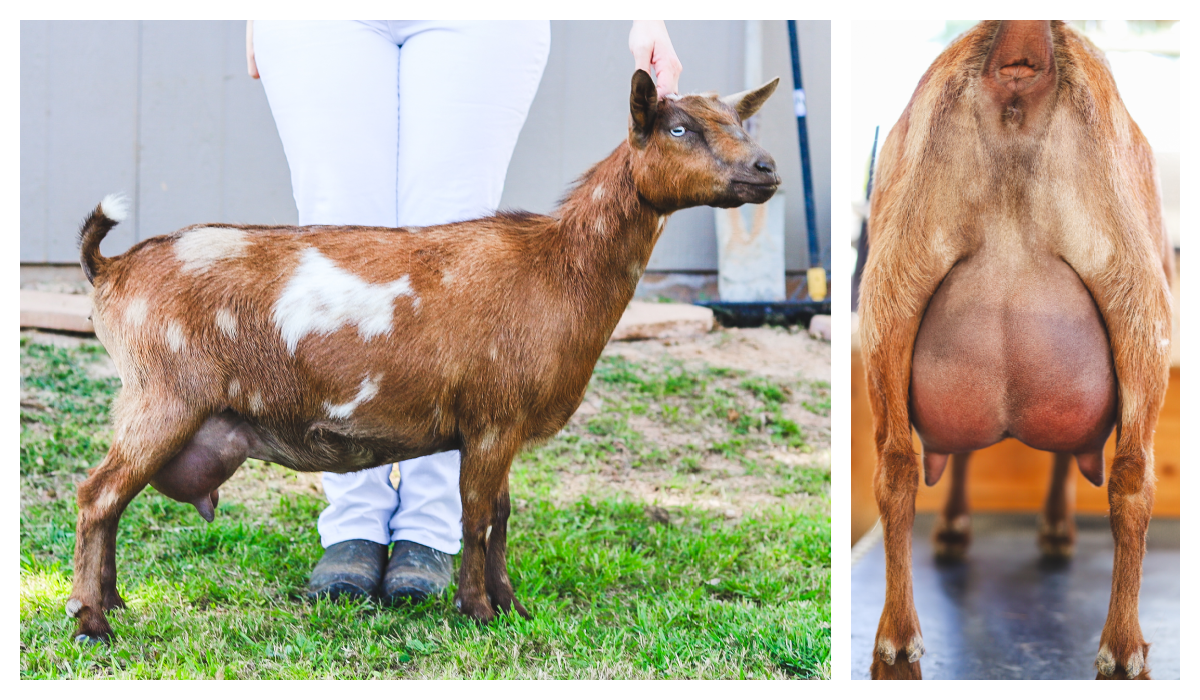
Screamer.
DUCHESS
2024-2025
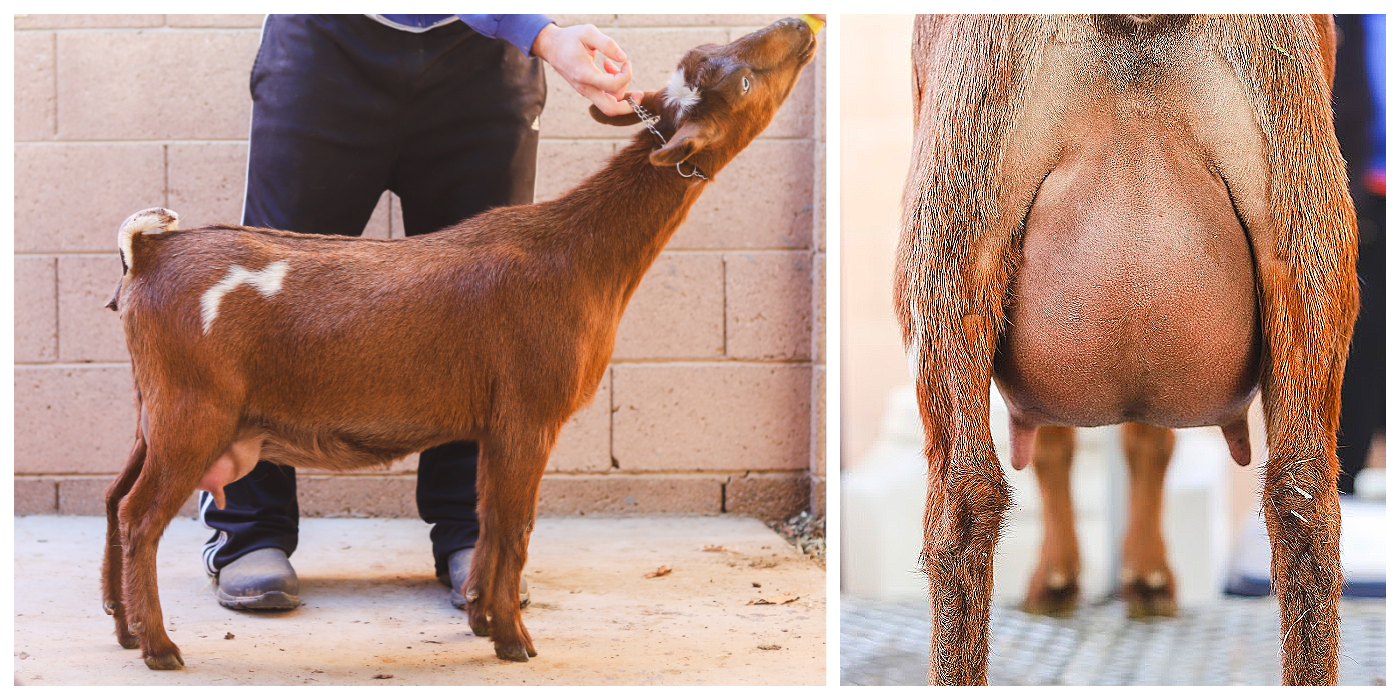
Duchess was the most elegant daughter born out of Wynonna & Lancelot. I worried a bit with how narrow she was in the rump, but decided to keep her anyway to have another Lancelot daughter to freshen.
Unfortunately, my suspicions were correct and that narrow rump just couldn't house her large mammary system.
Knowing that it's easy to improve udders but harder to improve actual body structure (aka rumps), I decided to let her go and focus on other does in the herd.
REBA
2022-2025
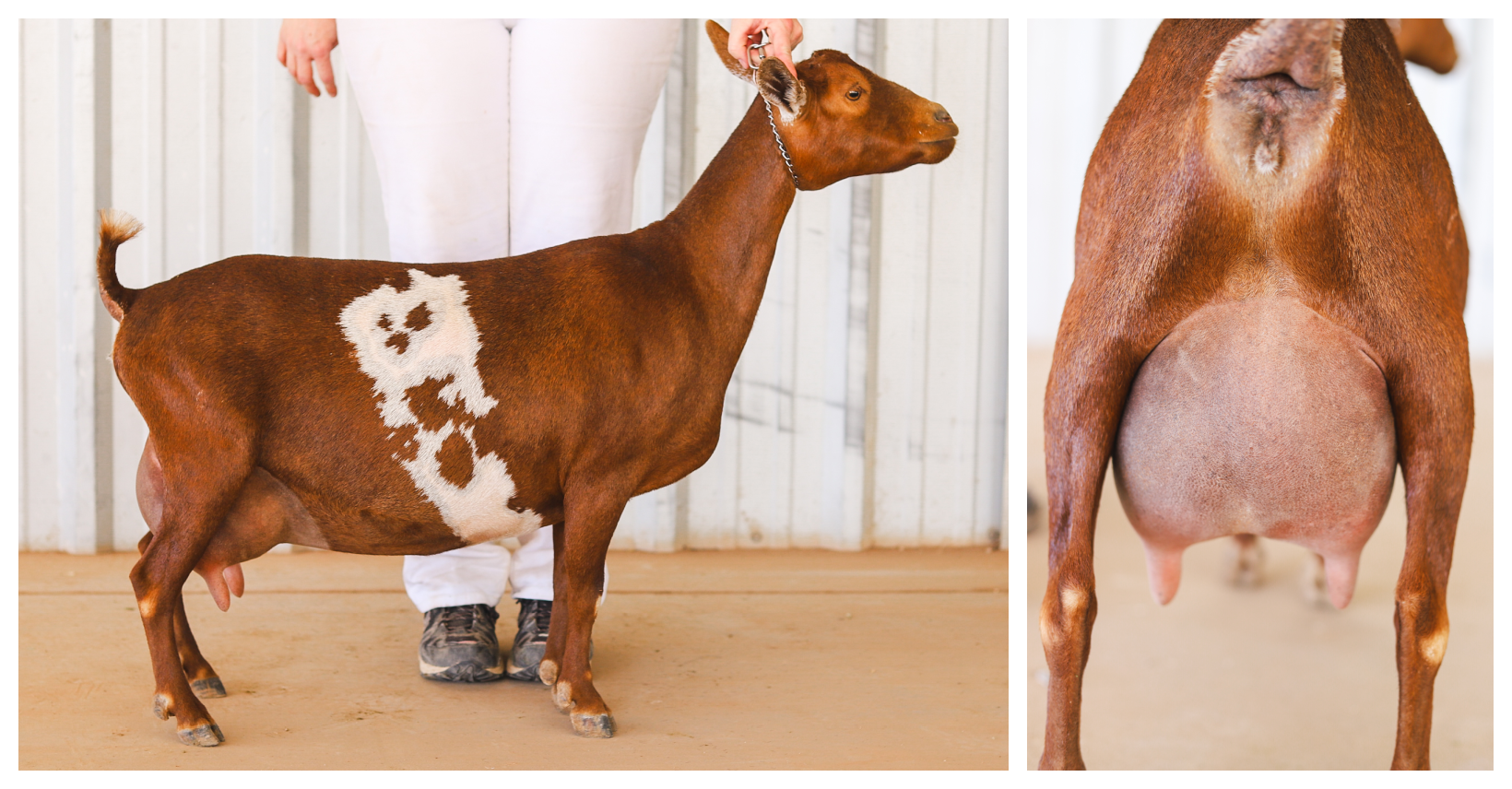
Oh Reba -- my heart! 🙁 Gosh, how I hate to put her on this page. Reba was the first doeling born out of a pairing of Daphne & Napoleon. Not only did I love her sweet personality, Reba had a nice long & deep body as well as a really nice udder.
Unfortunately, after her 3rd pregnancy, she really started to break down. I noticed her feet bending, her pasterns weakening, and overall just watching her walk around the pasture I knew she wasn't moving with ease. I made the decision to retire her and now she lives on a farm as a companion to an old horse. Since she's a loner and likes to be away from the chaos of the herd, I felt like this was a good fit for her.
LANCELOT
2023-2025
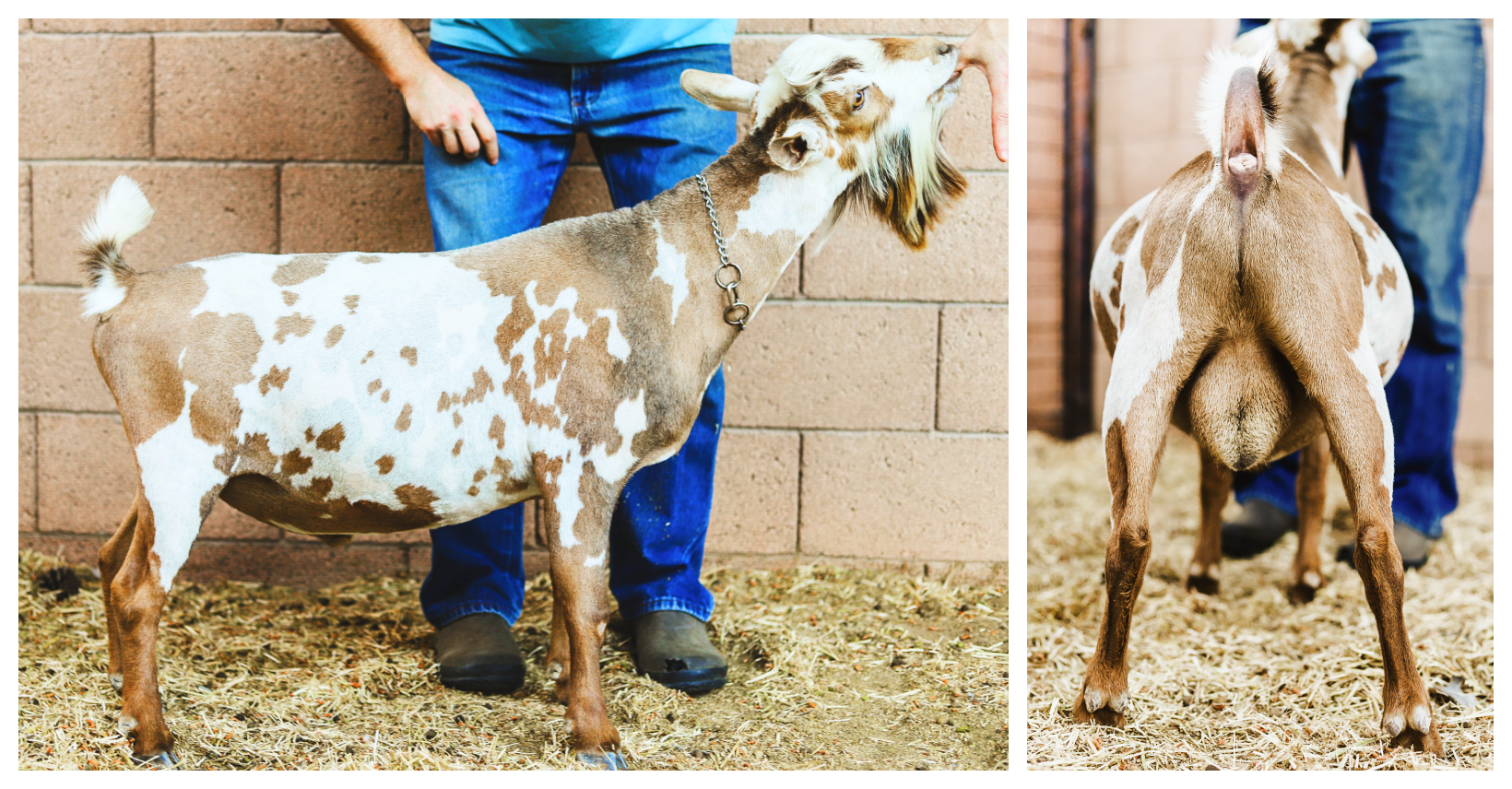
Lancelot was a really hard one to let go. I orginally purchased him because his dam had a phenomenal rear udder score of 47 (!) Unfortunately, it seemed like he didn't really push his udder genetics through and almost all of his kids ended up having their dam's udder. He did improve shoulders and passed down nice long necks which was awesome! In the end I decided to let him go and focus on another new line in an effort to improve udders, as that's my priority right now.